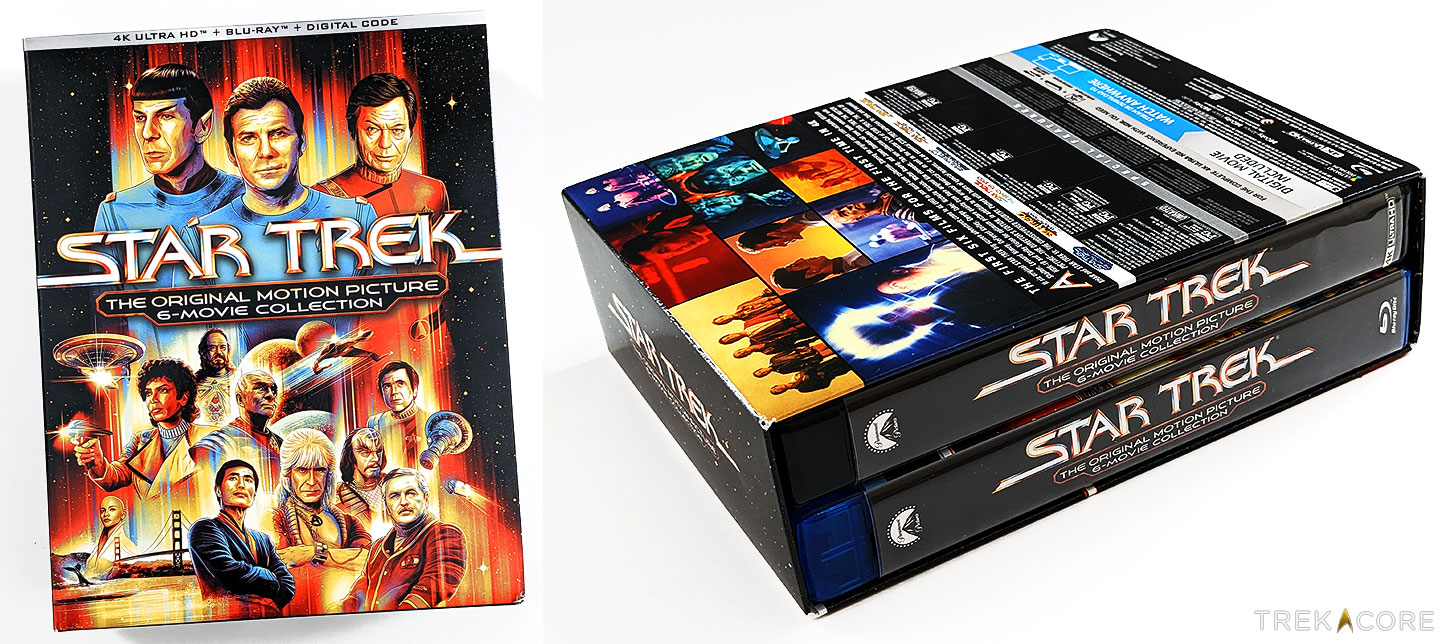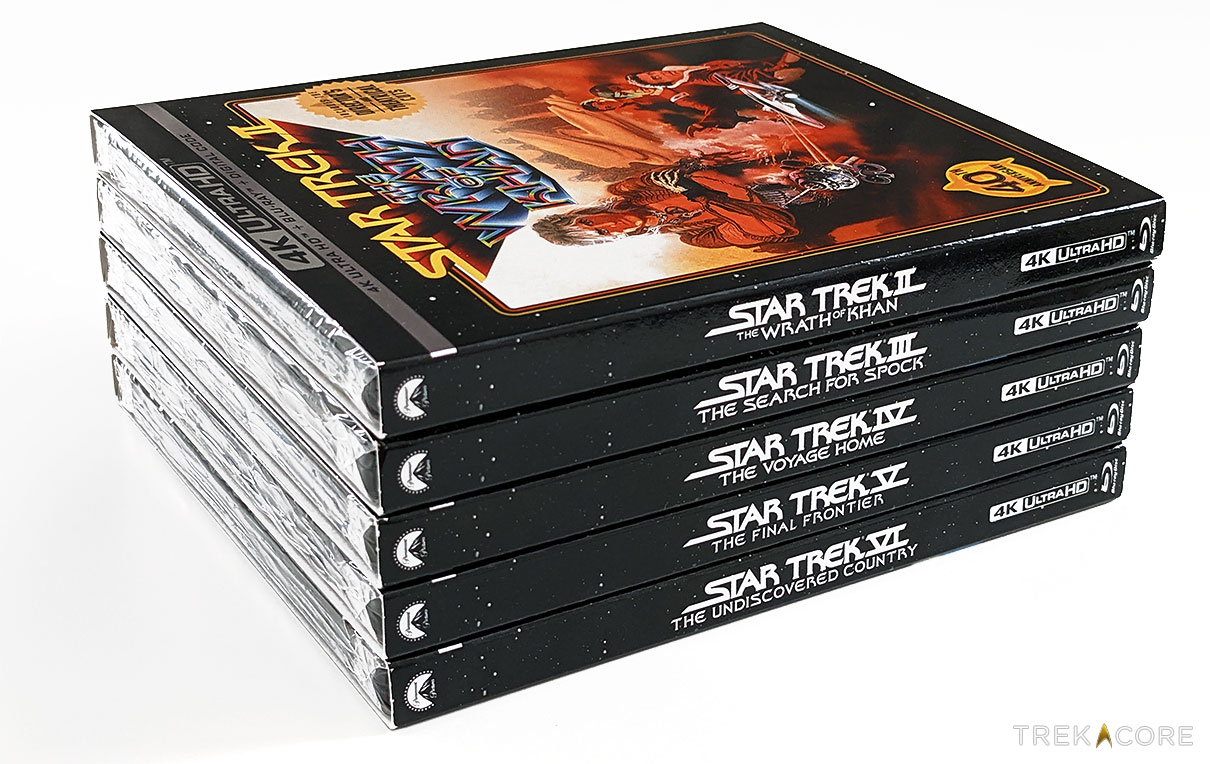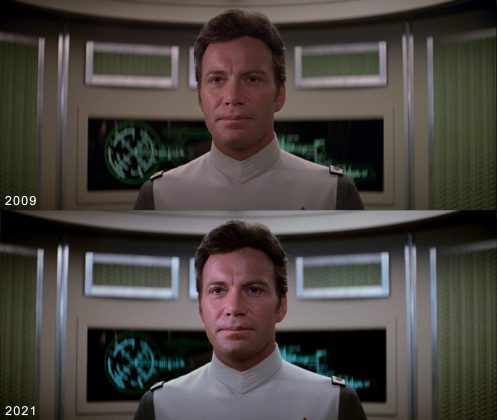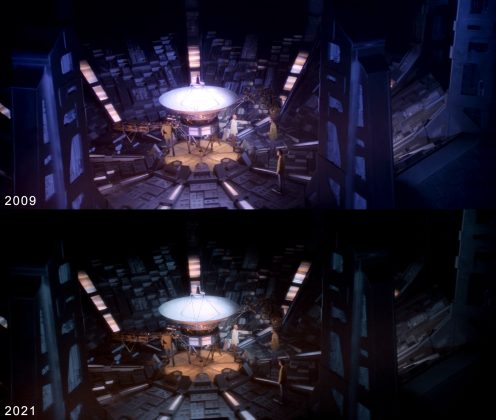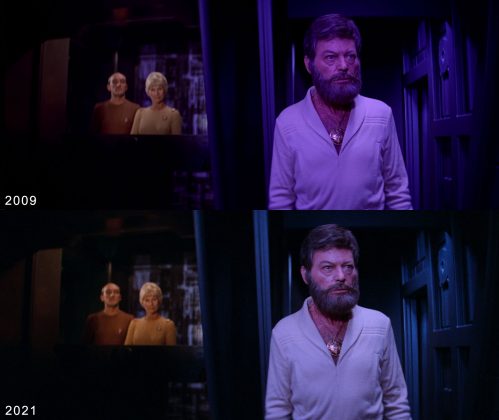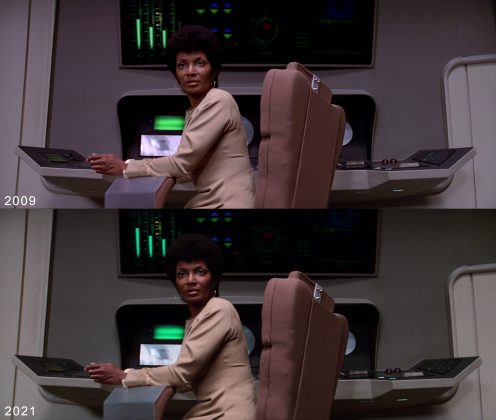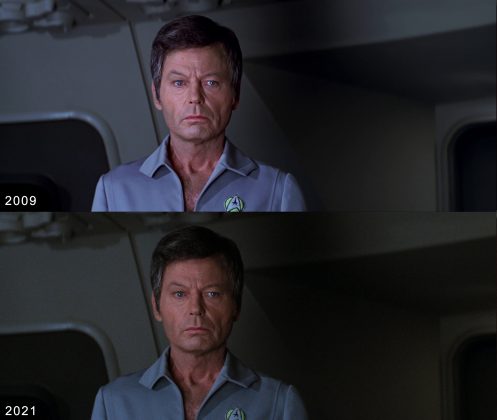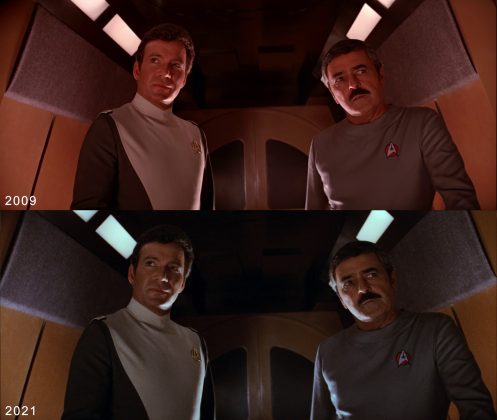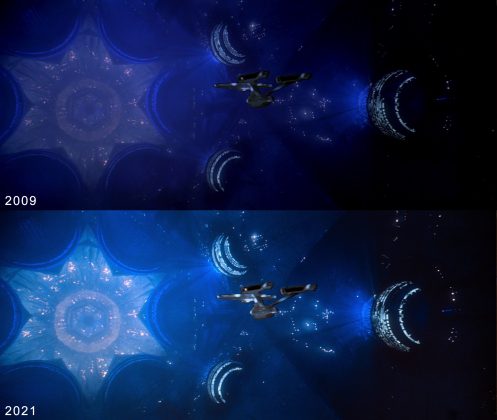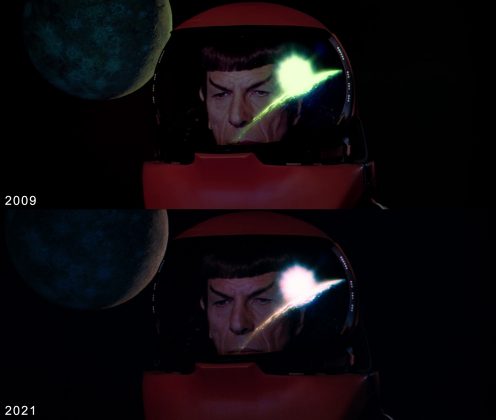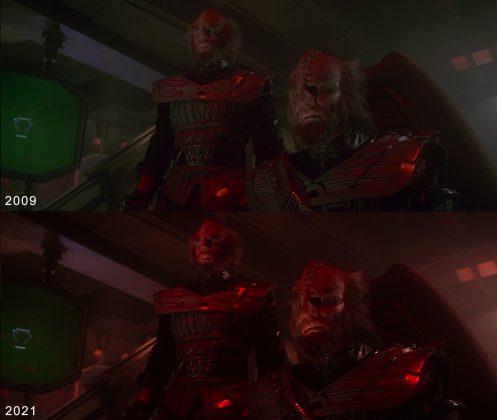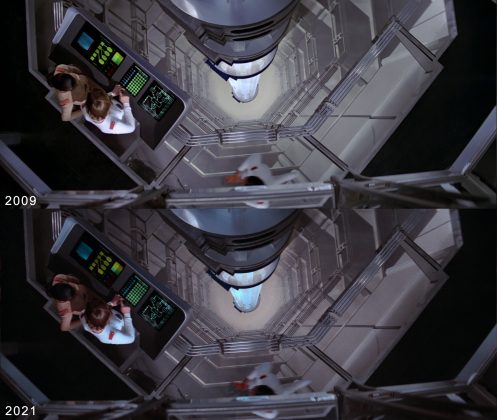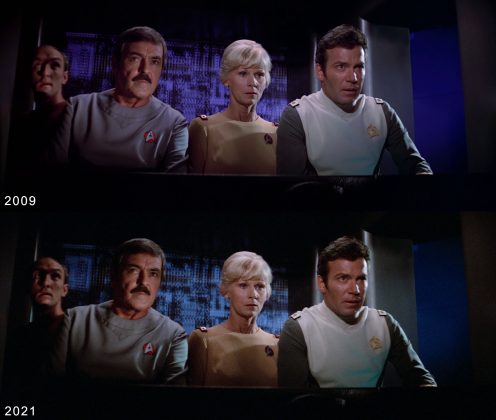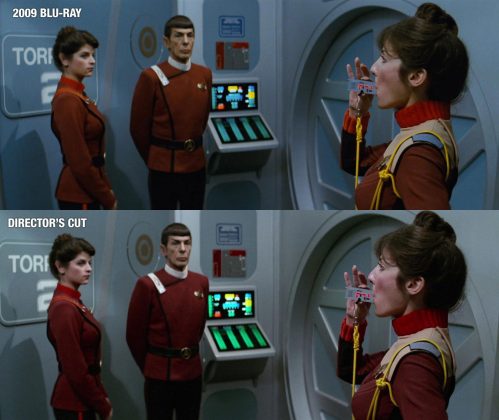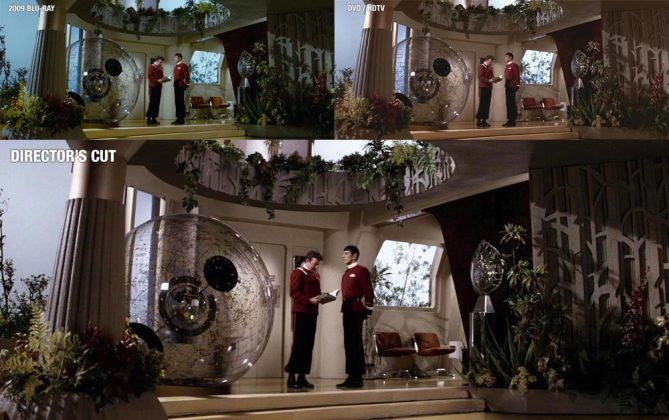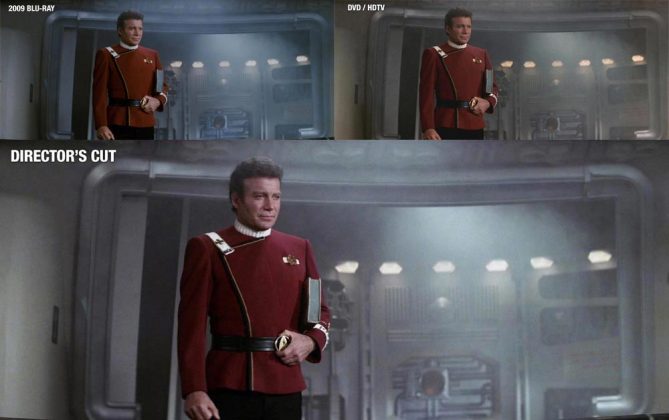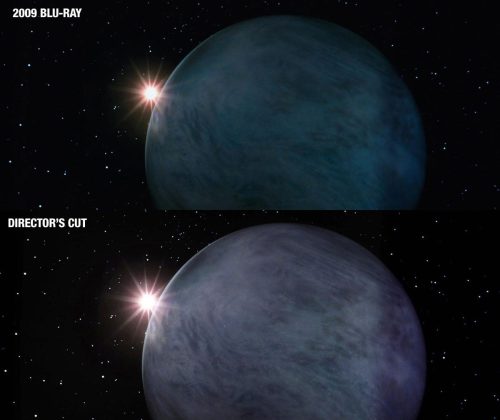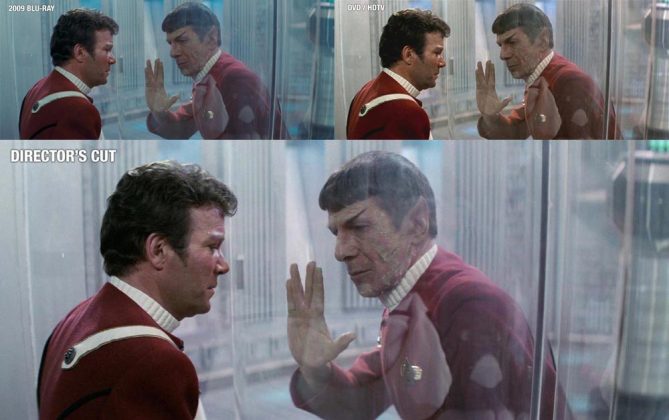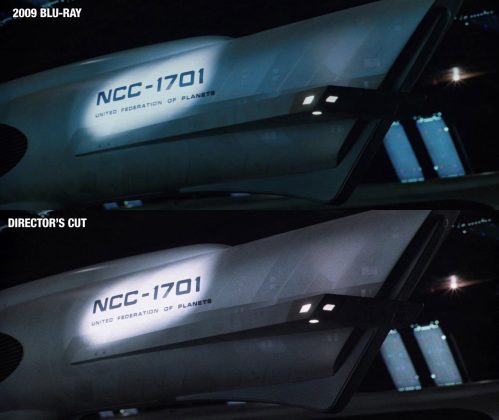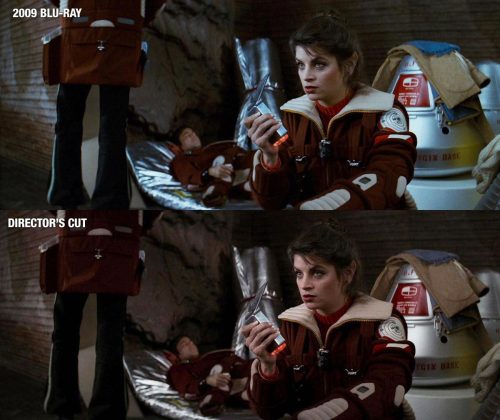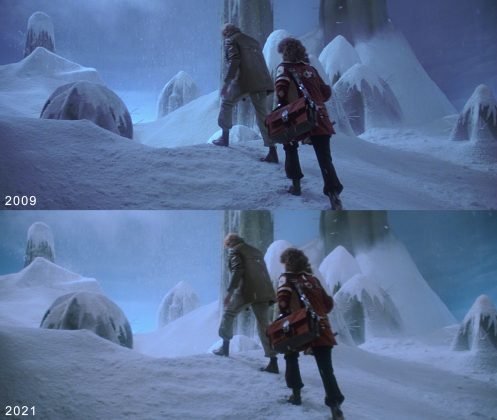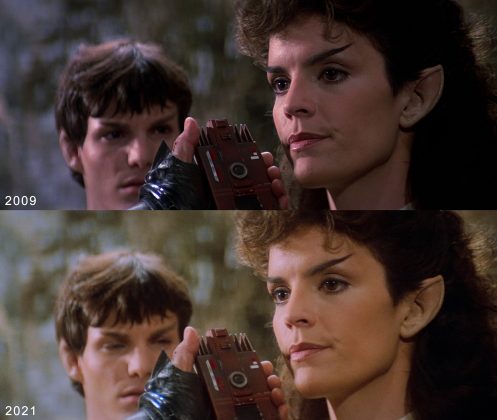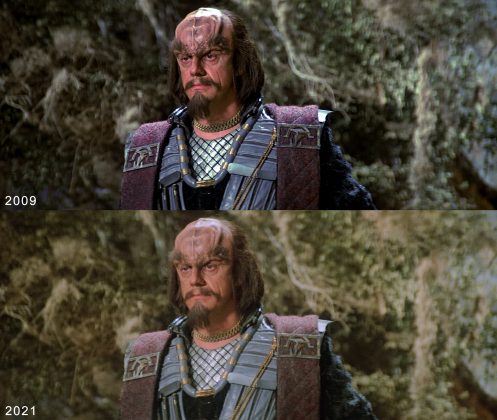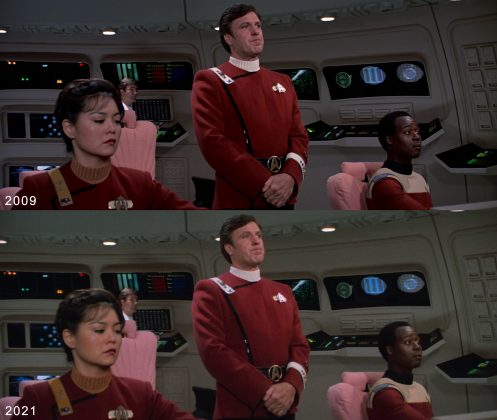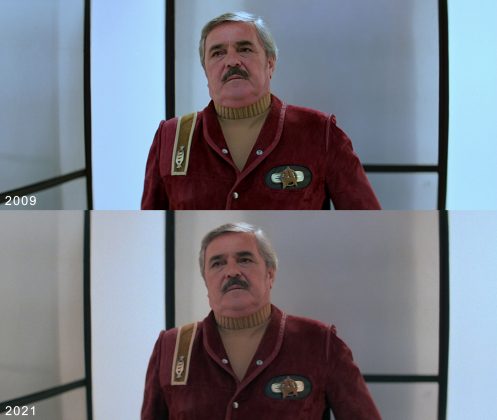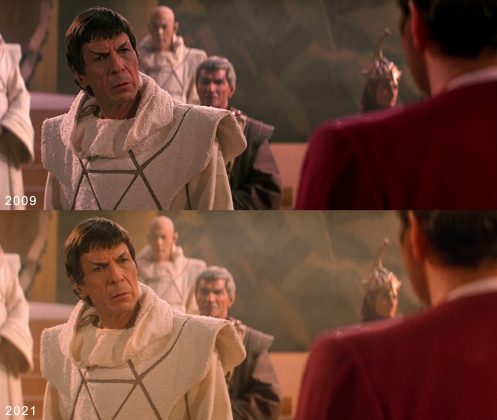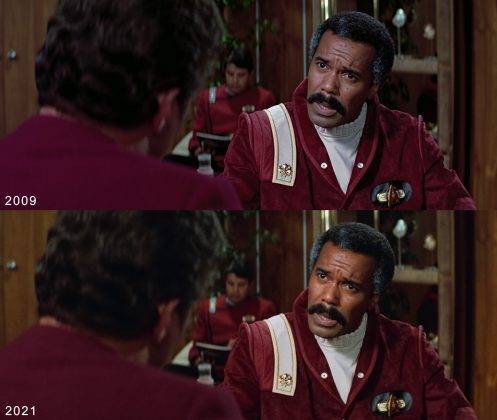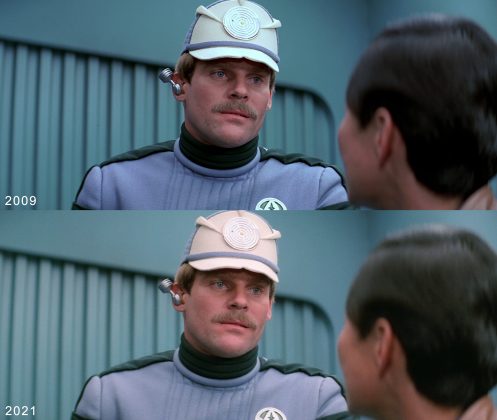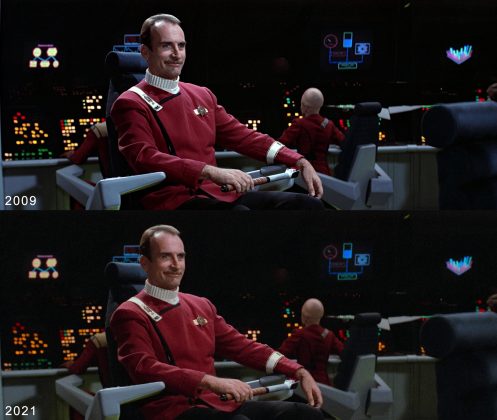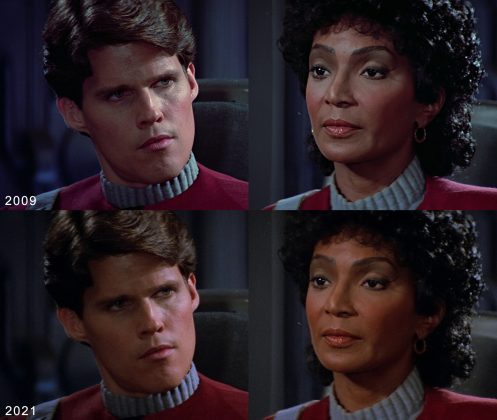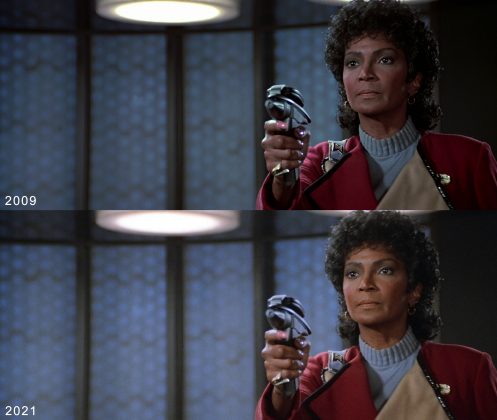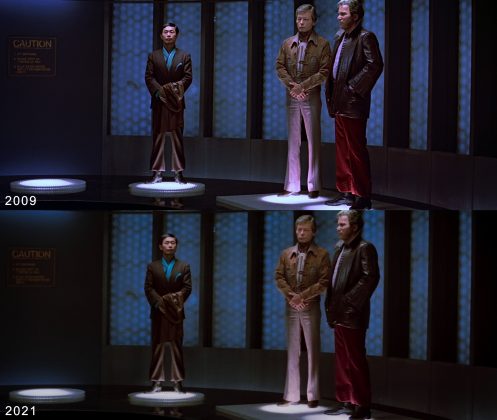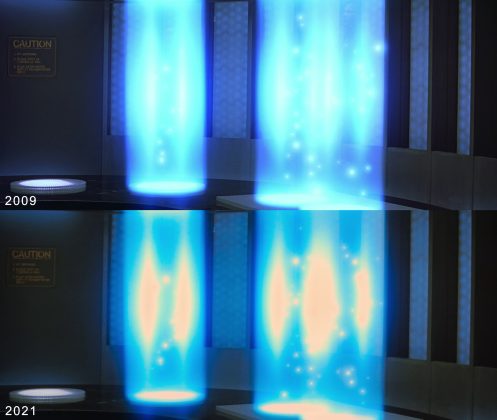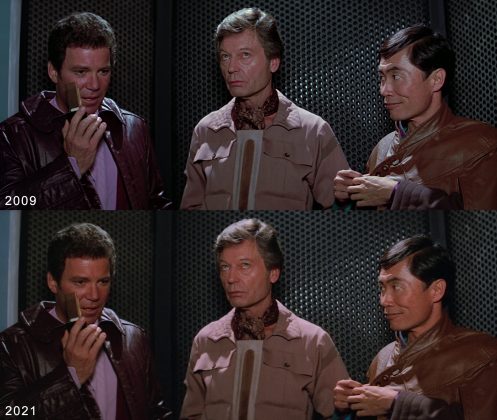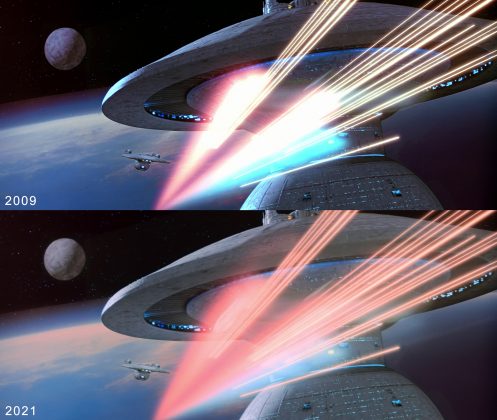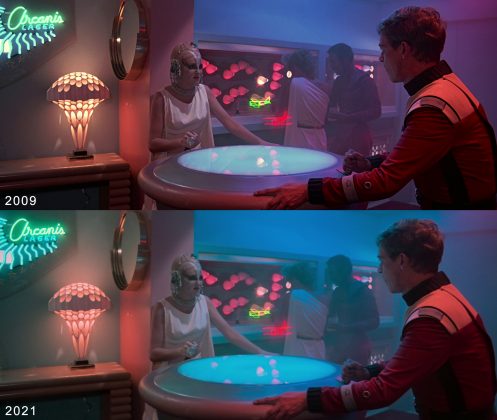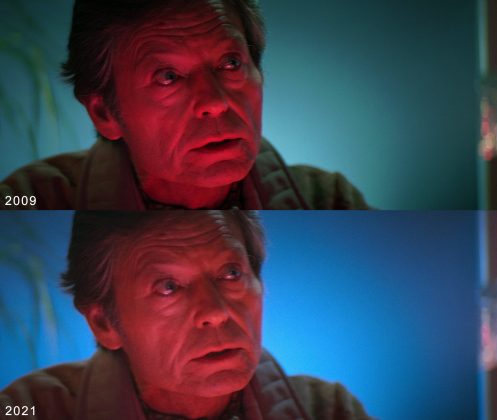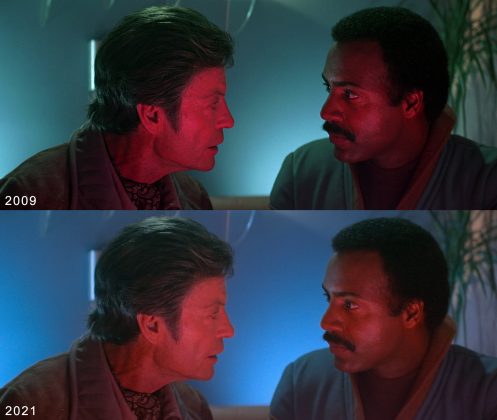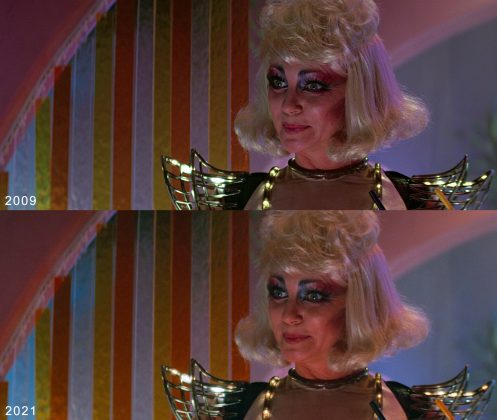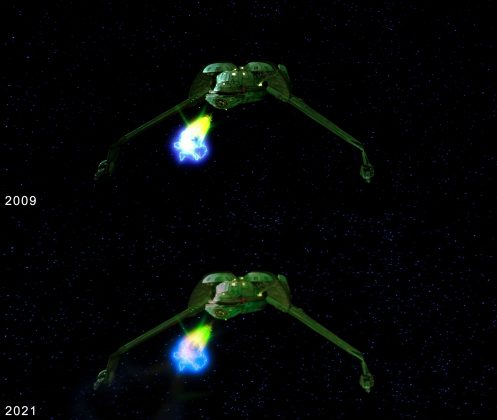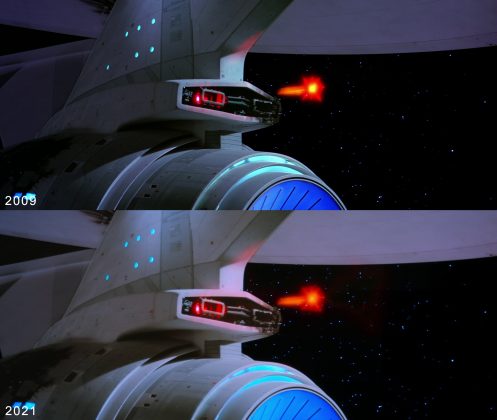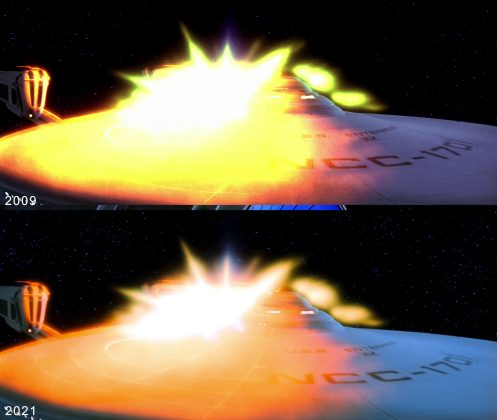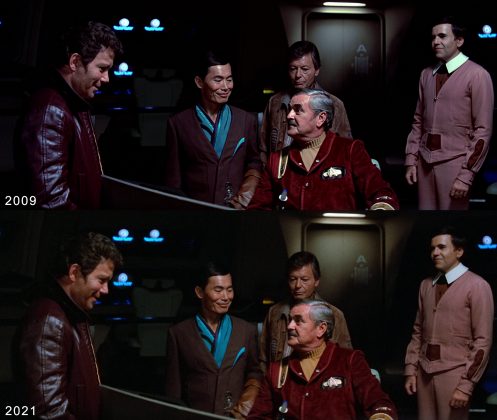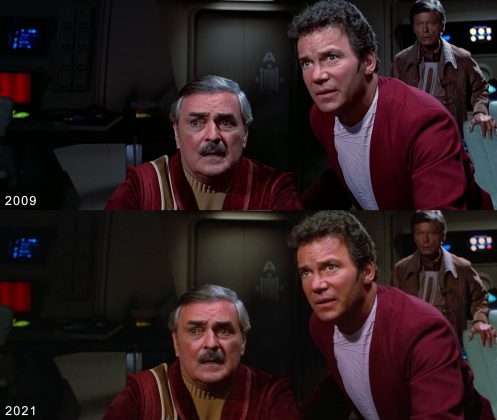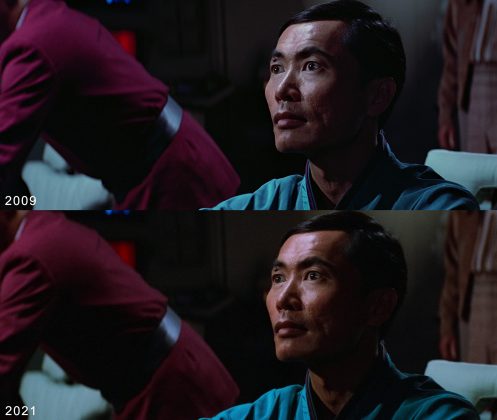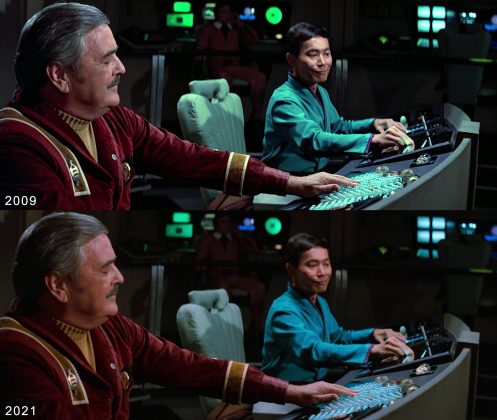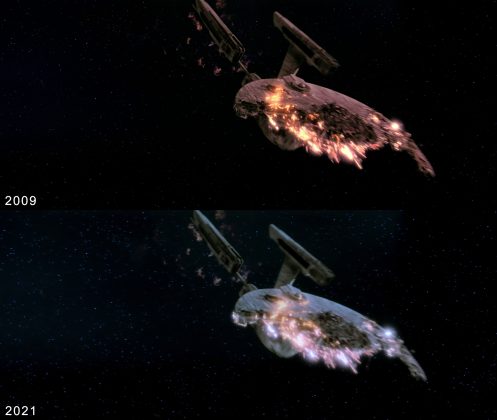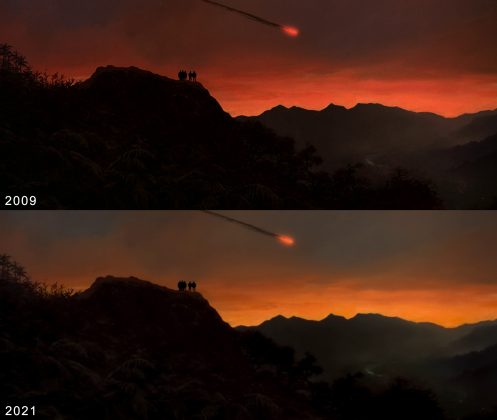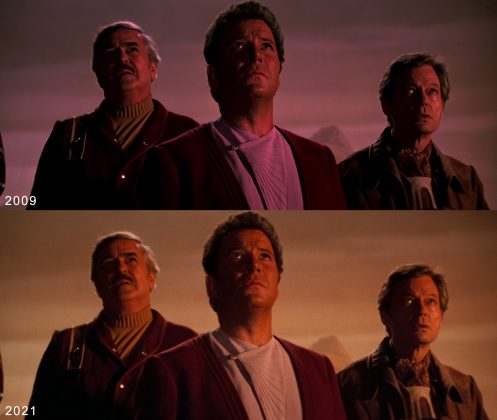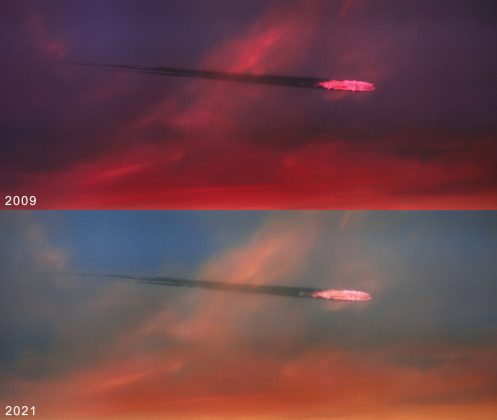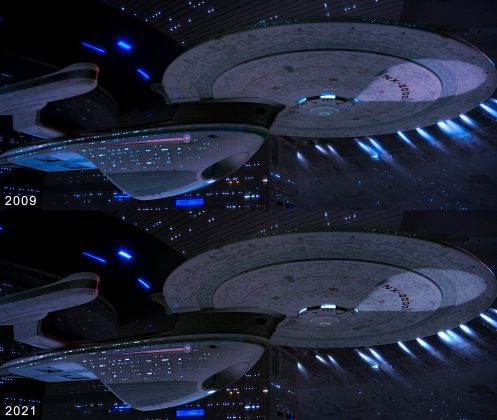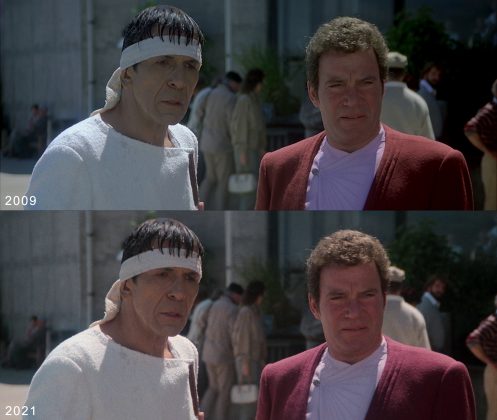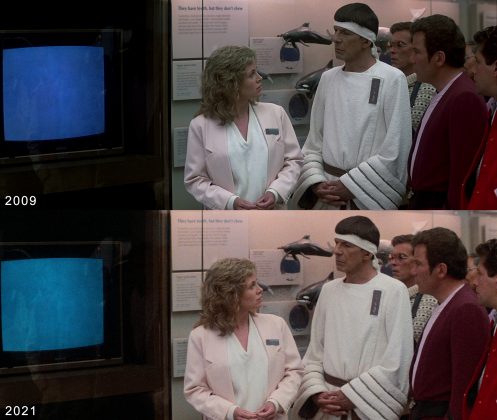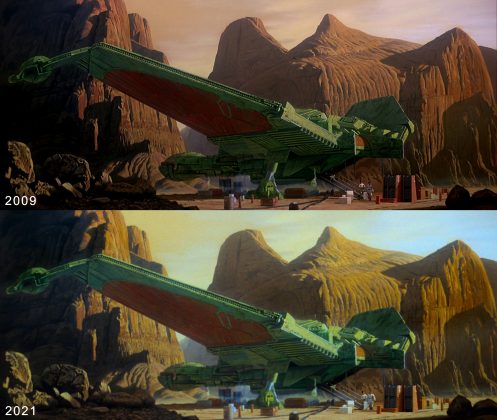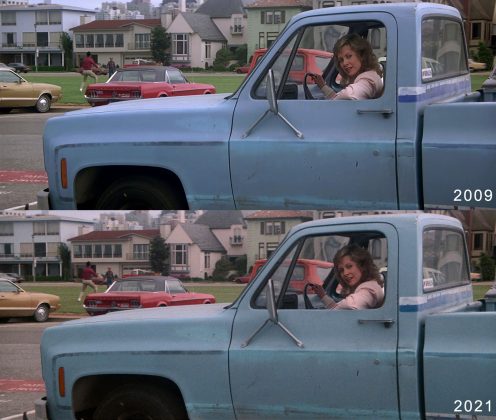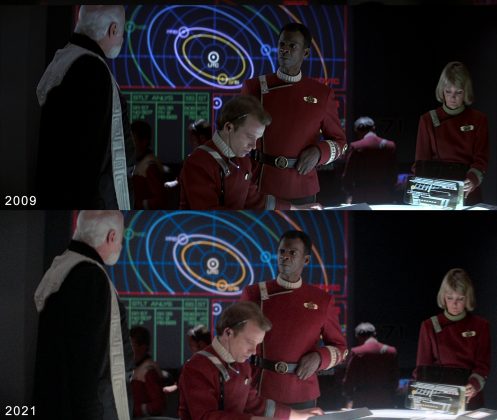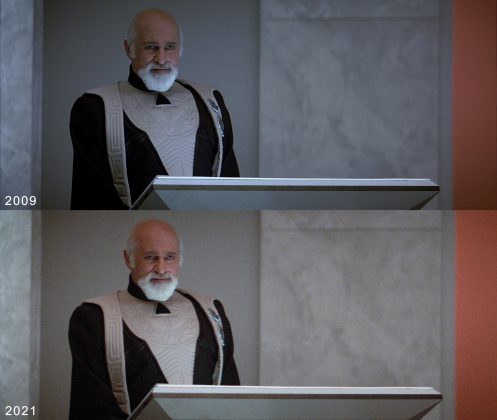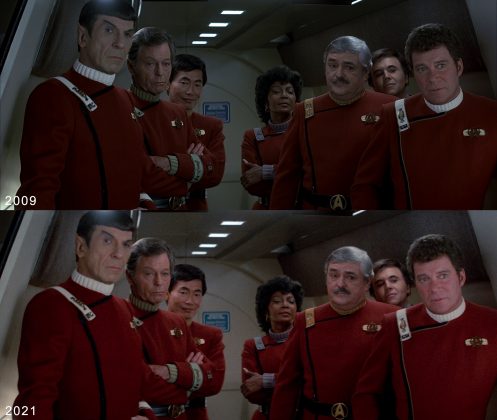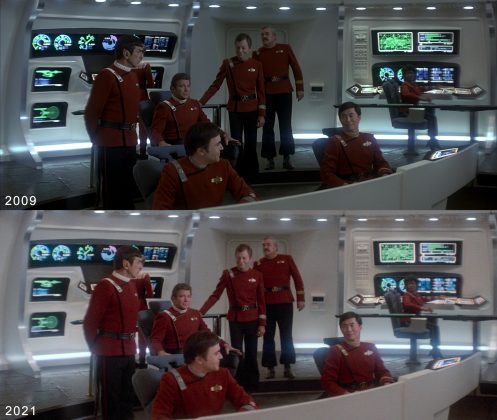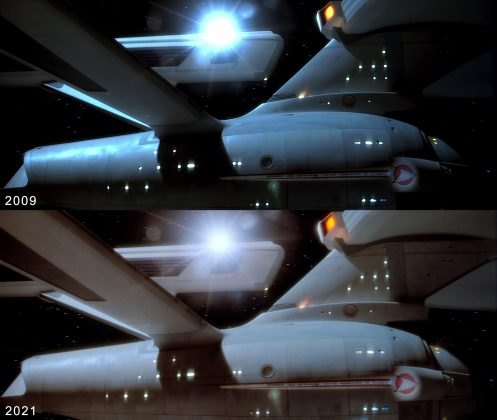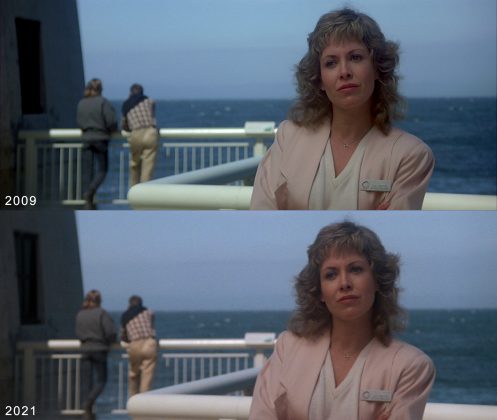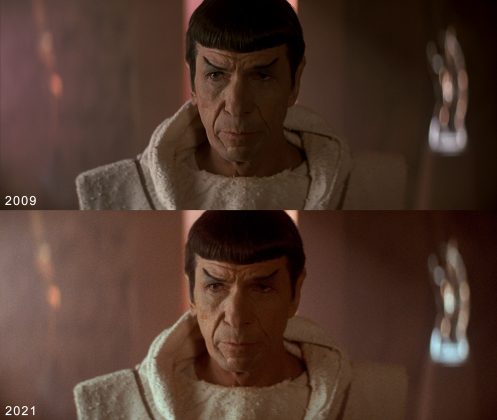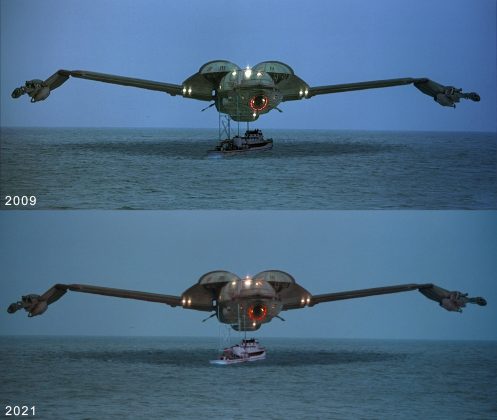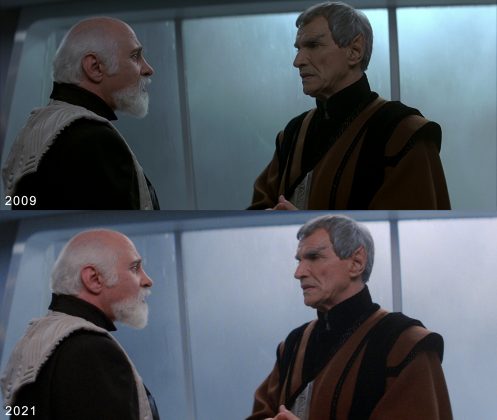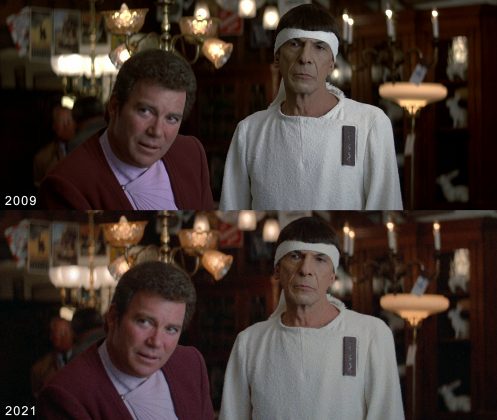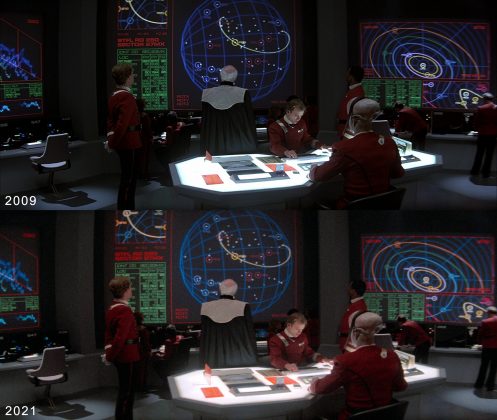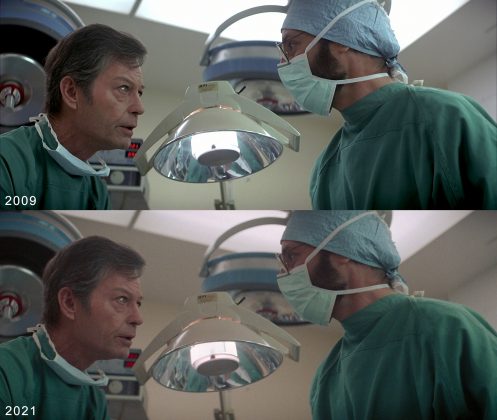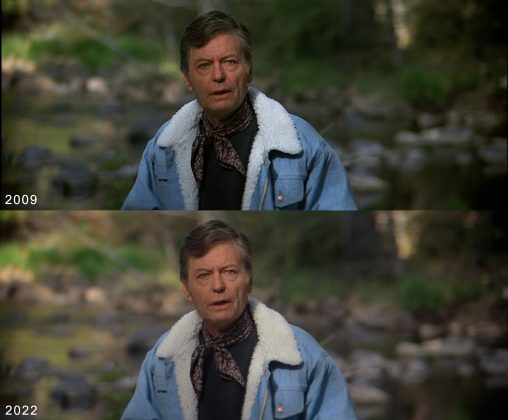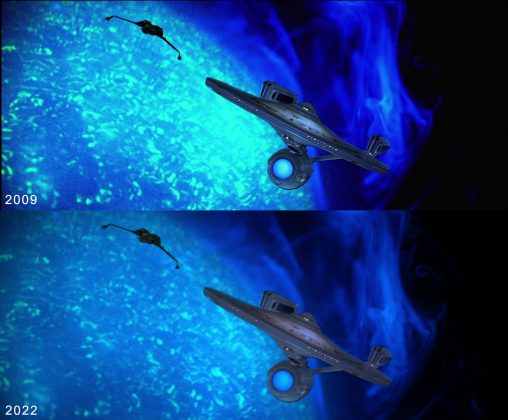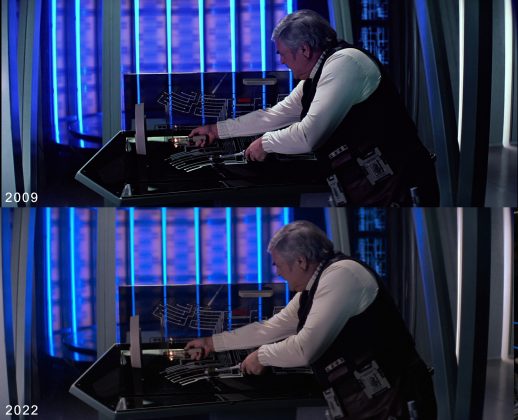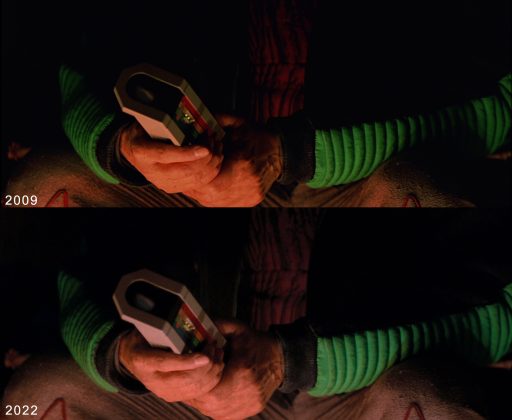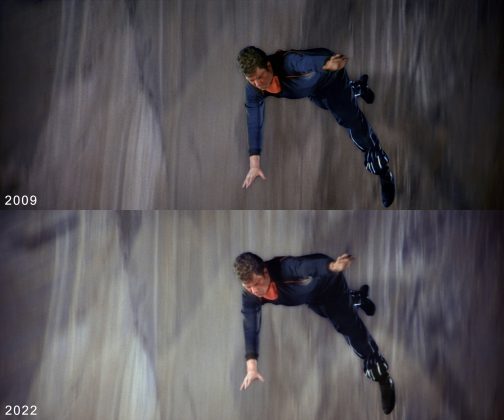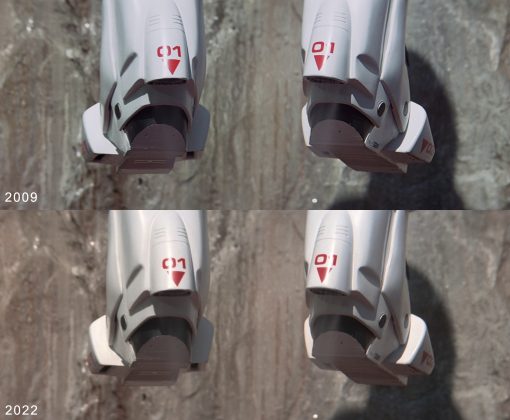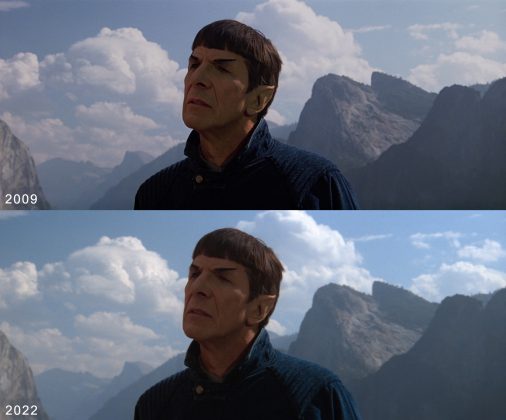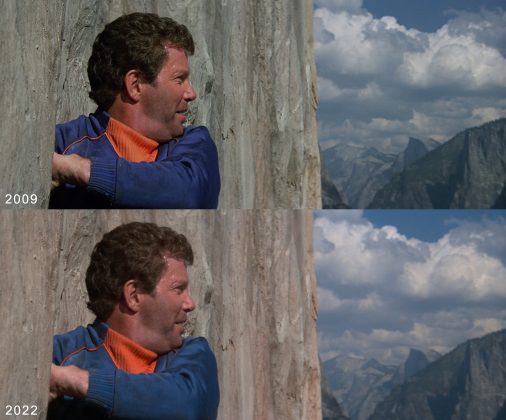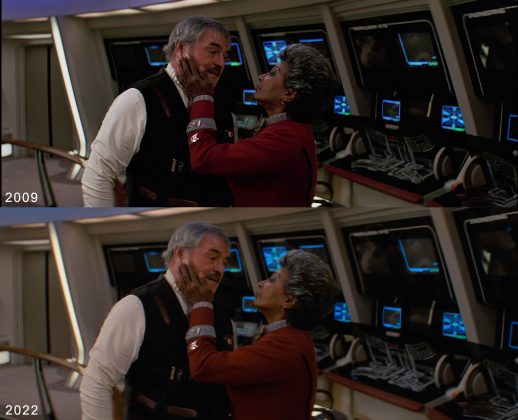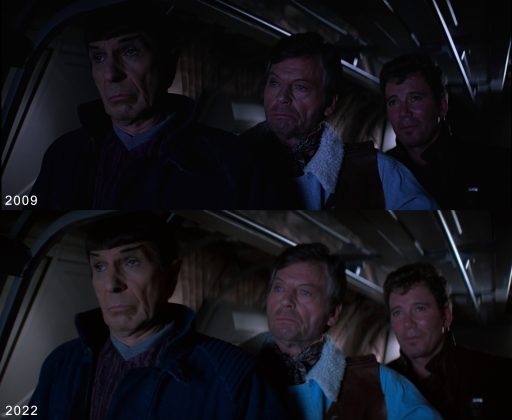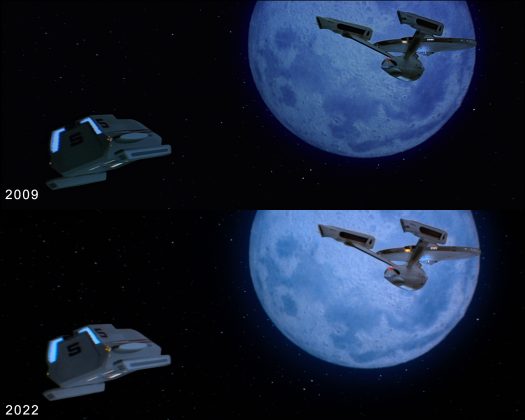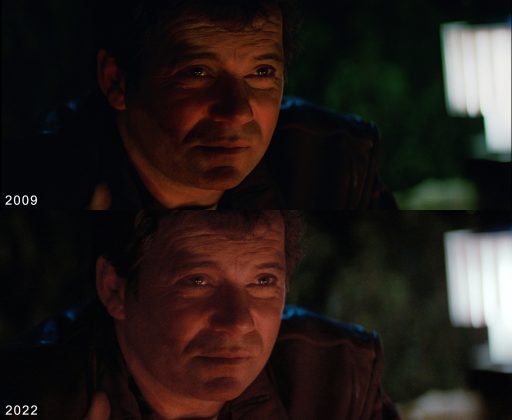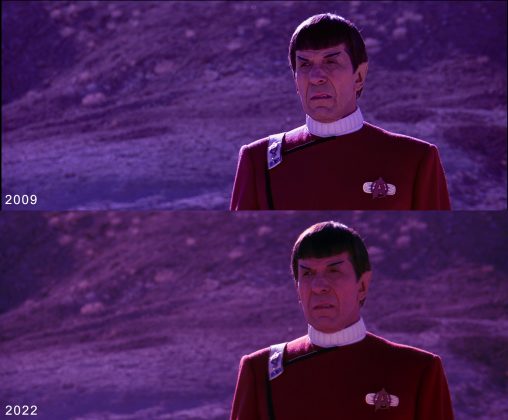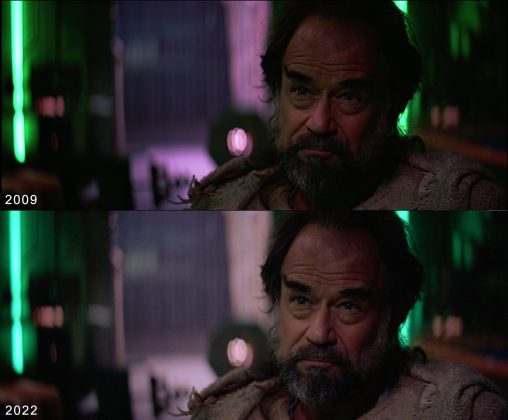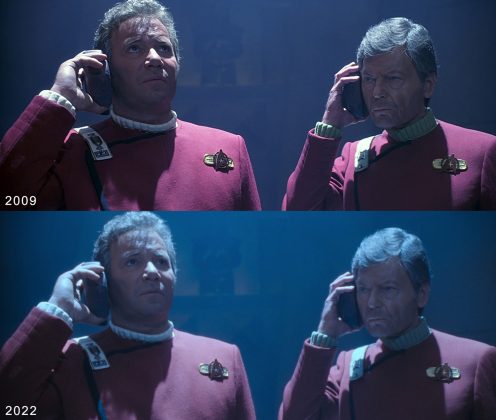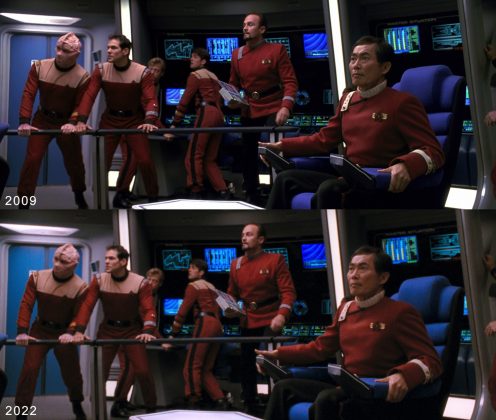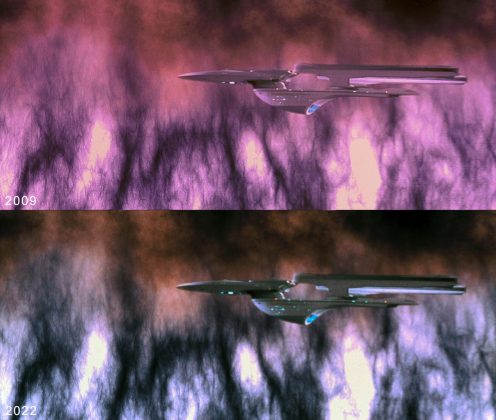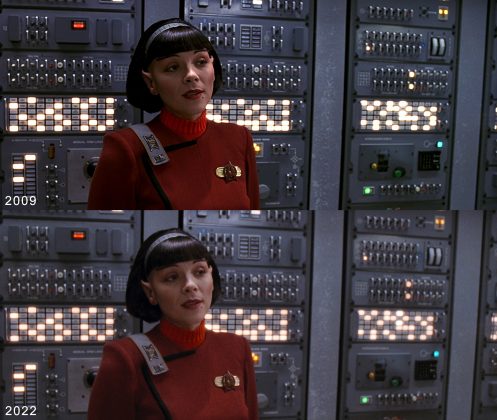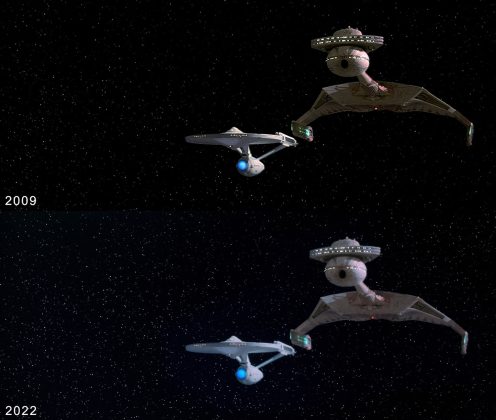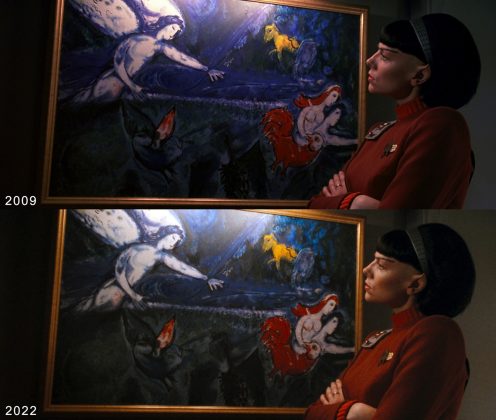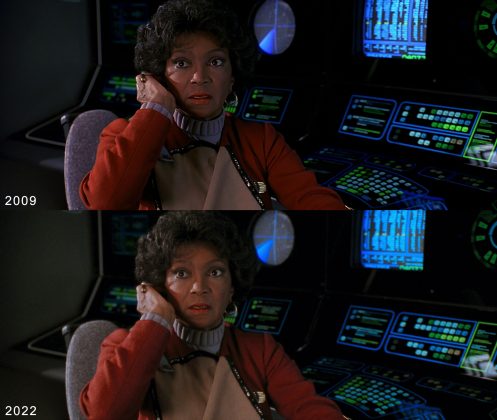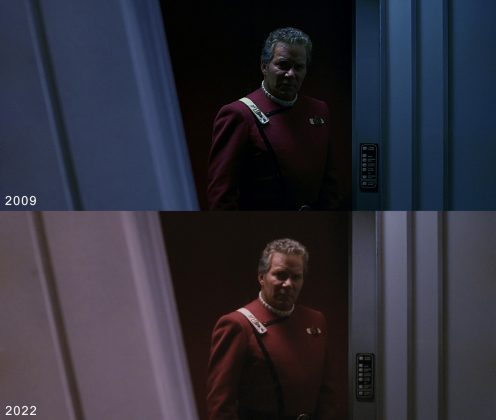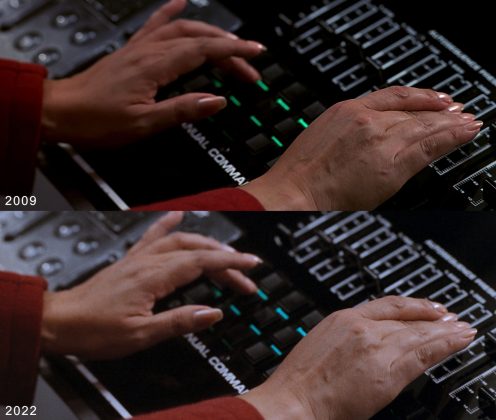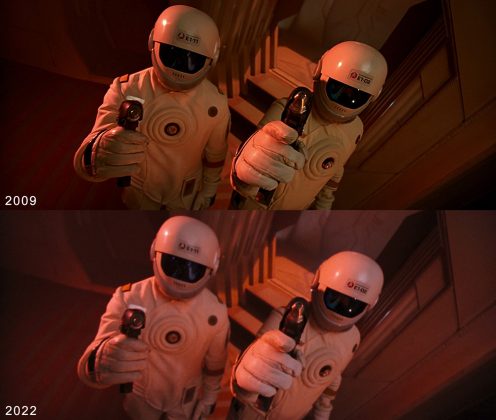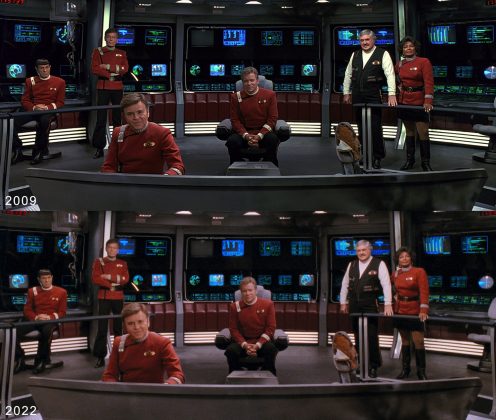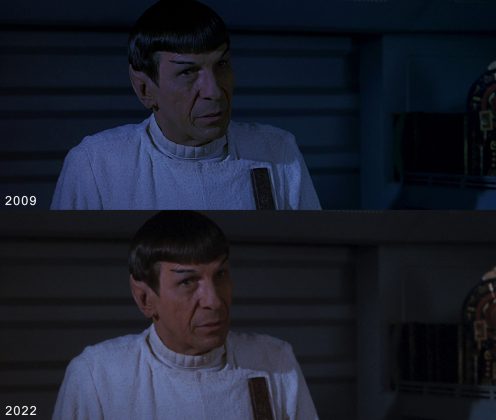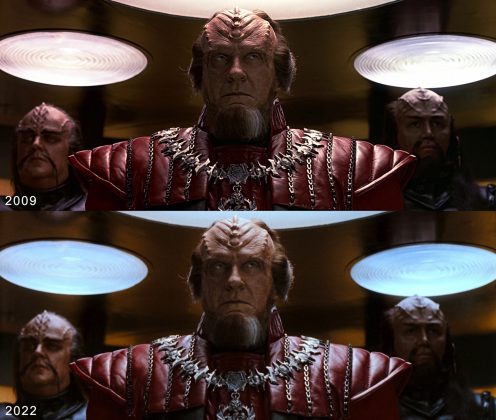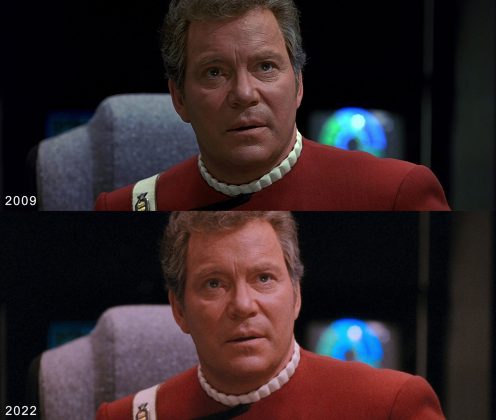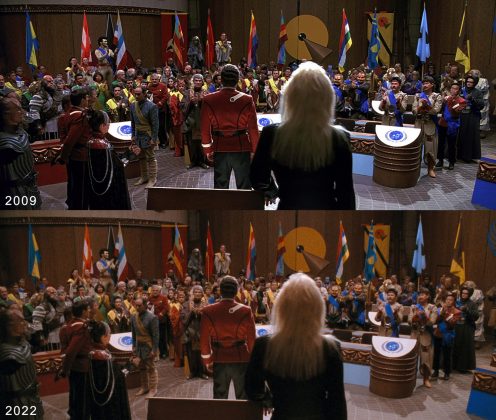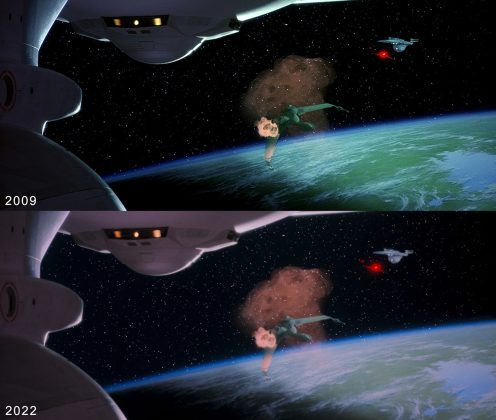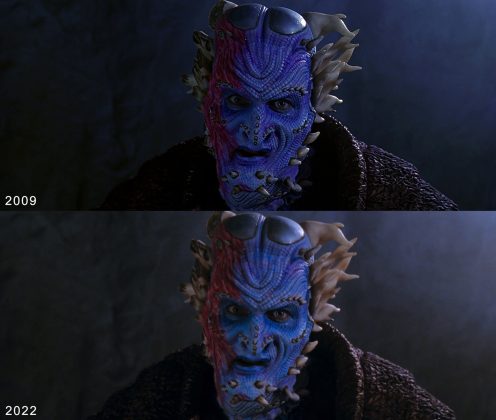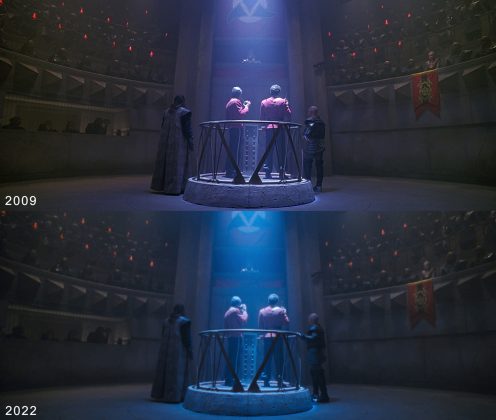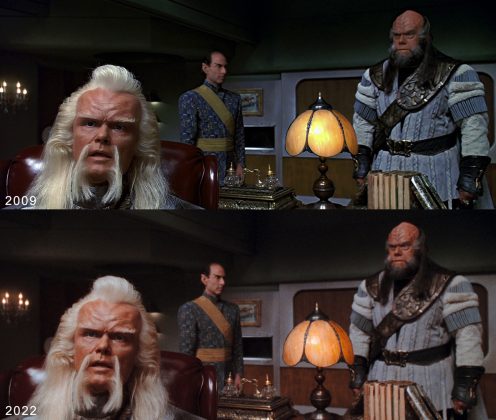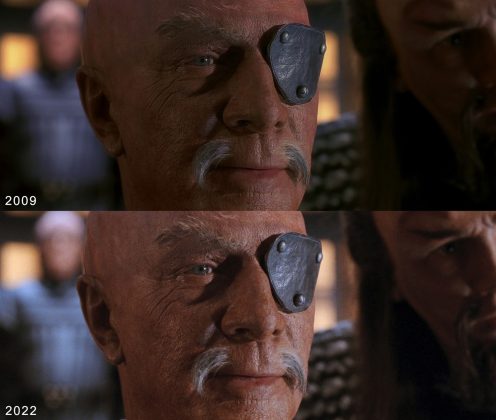A QUICK NOTE: Today’s review covers everything EXCLUDING the new 4K release of “Star Trek: The Motion Picture — The Director’s Edition,” which we hope to have reviewed in the near future.
At long last, all six of the classic Star Trek crew’s big-screen adventures are available to fans in new 4K Ultra HD presentations, rescanned from the original negatives and preserved without the heavy-handed, artificial modifications that have plagued the movies since their first high-definition release in 2009.
While the first four remastered films hit 4K and Blu-ray in 2021, we now have the complete collection — including the Director’s Edition of The Motion Picture and Director’s Cuts of The Wrath of Khan and The Undiscovered Country — fully restored and ready to replace the in-our-opinion highly-inferior scans released more than a decade ago.
The new 15-disc collection includes all of the following:
-
- Star Trek: The Motion Picture (Theatrical Cut)
- 4K Blu-ray Disc and Blu-ray Disc
- Star Trek: The Motion Picture – The Director’s Edition
- 4K Blu-ray Disc and Blu-ray Disc
- Bonus Features Blu-ray Disc
- Star Trek II: The Wrath of Khan
- 4K Blu-ray Disc — Theatrical Cut and Director’s Cut
- Blu-ray Disc — Theatrical Cut and Director’s Cut
- Star Trek III: The Search for Spock
- 4K Blu-ray Disc and Blu-ray Disc
- Star Trek IV: The Voyage Home
- 4K Blu-ray Disc and Blu-ray Disc
- Star Trek V: The Final Frontier
- 4K Blu-ray Disc and Blu-ray Disc
- Star Trek VI: The Undiscovered Country
- 4K Blu-ray Disc — Theatrical Cut and Director’s Cut
- Blu-ray Disc — Theatrical Cut only
- Star Trek: The Motion Picture (Theatrical Cut)
Standalone 4K / Blu-ray combo pack releases of Star Trek II, II, IV, V, and VI also arrived this week:
There will certainly be debates over “correct” color timing and lighting levels between the 2009 and the 2021/2022 editions of the original Star Trek films: each film does seem to have an issue with somewhat brighter-than-expected lighting levels, especially in space scenes, which seems to be a side effect from creating the remastered Blu-rays from 4K HDR sources.
A NOTE ON SCREENCAPS: At present, it is rather difficult to produce representative screencaps from 4K discs and maintain the full HDR color presentation for online publication. The remastered Blu-rays, which are based upon the 4K presentations, are what we can produce and share for this review.
We’ve watched the 4K discs on a proper HDR television display, and can say that those of you who will primarily watch the films on 4K discs on 4K HDR-capable displays (or on streaming services which present the full 4K HDR presentation) will probably not notice much of an issue on that front — but “downgrading” the new scans to 1080p for the standard Blu-ray discs have left some scenes feel a bit over-brightened, losing some of the shadowy moods one remembers from countless viewings over the decades.
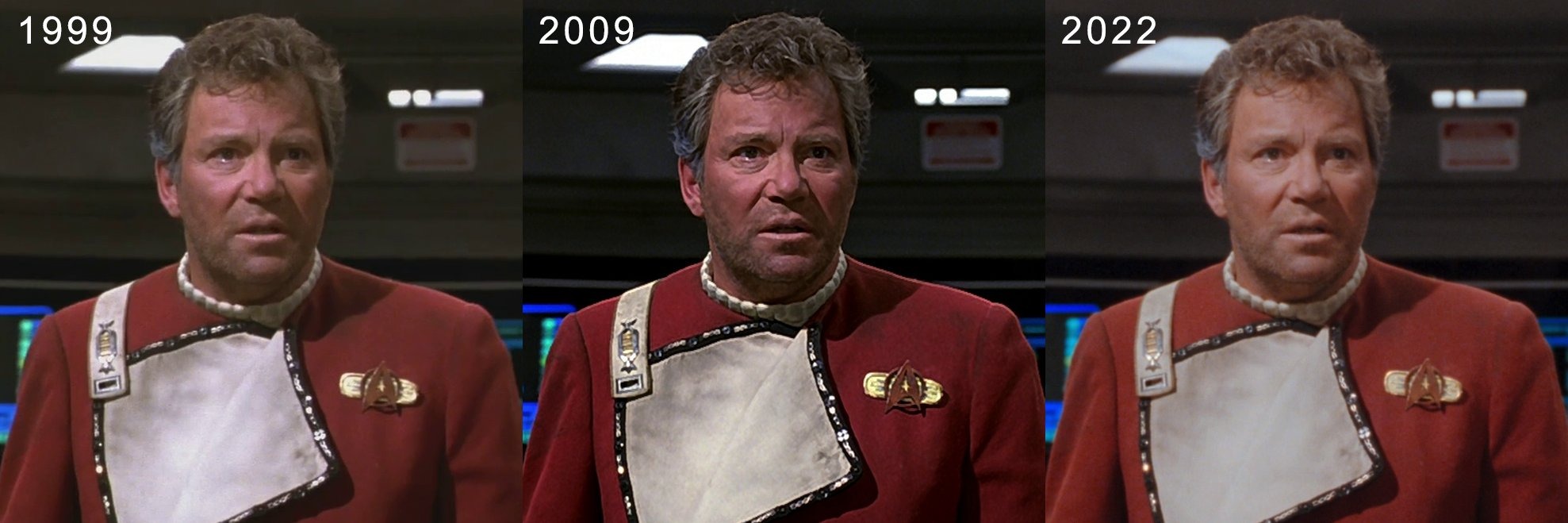

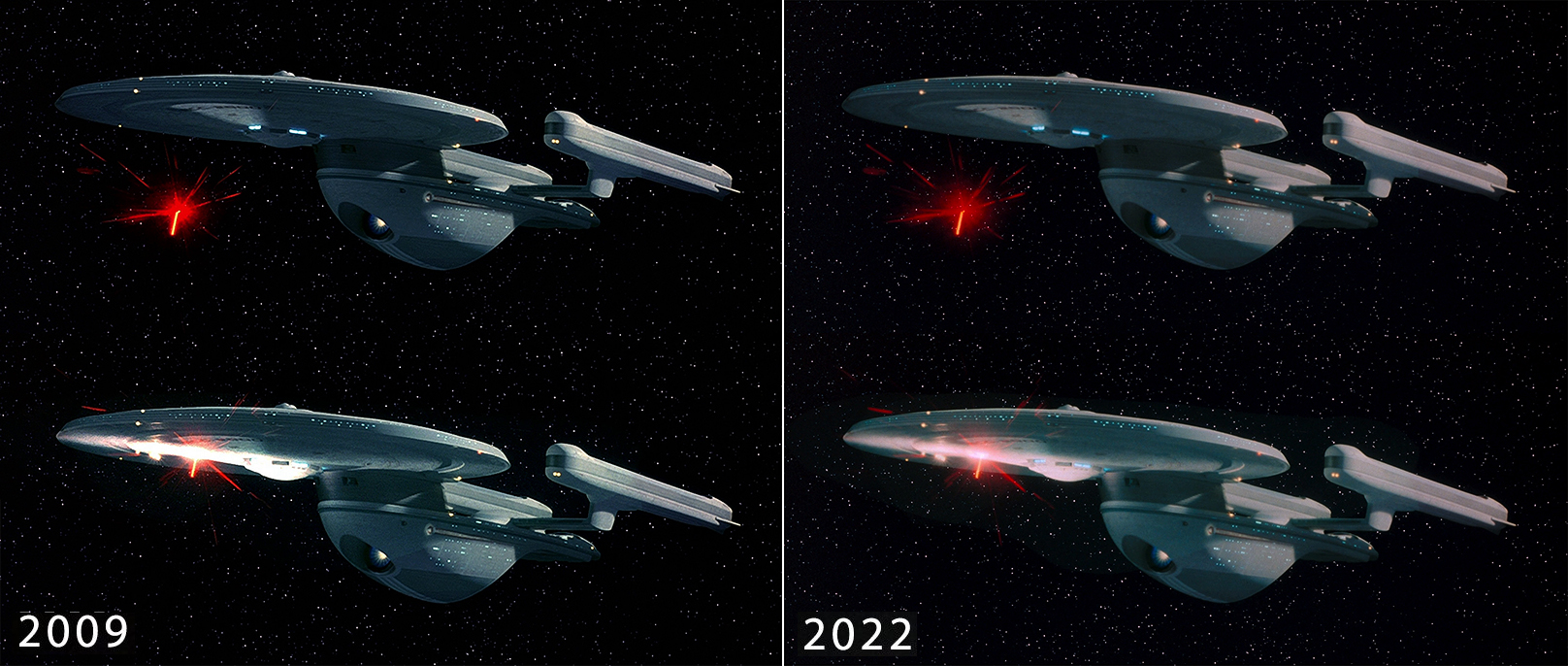
That said — the primary problem with those first Blu-ray editions are the tragically-overused Digital Noise Reduction (DNR) and edge-enhancement (or “sharpening”) techniques used when bring the movies to HD for the first time.
For the 2009 editions, all six films were put through DNR processing to “scrub out” the natural film grain that was part of the original presentation, and then each were artificially sharpened to restore the detail lost because of the DNR pass — resulting in a strange mix of heavily-shadowed, chiseled faces, waxy skin features erasing the actors’ natural complexions, and elimination of much of the costumes’ and sets’ surface detailing.
Probably the most impacted by the DNR/sharpening effect was Star Trek VI, which in some scenes left the cast looking like clay sculptures brought to life — such as the below shot from Spock’s briefing at the beginning of the film — but the other films are impacted as well in varying degrees, as we’ve illustrated from The Motion Picture.
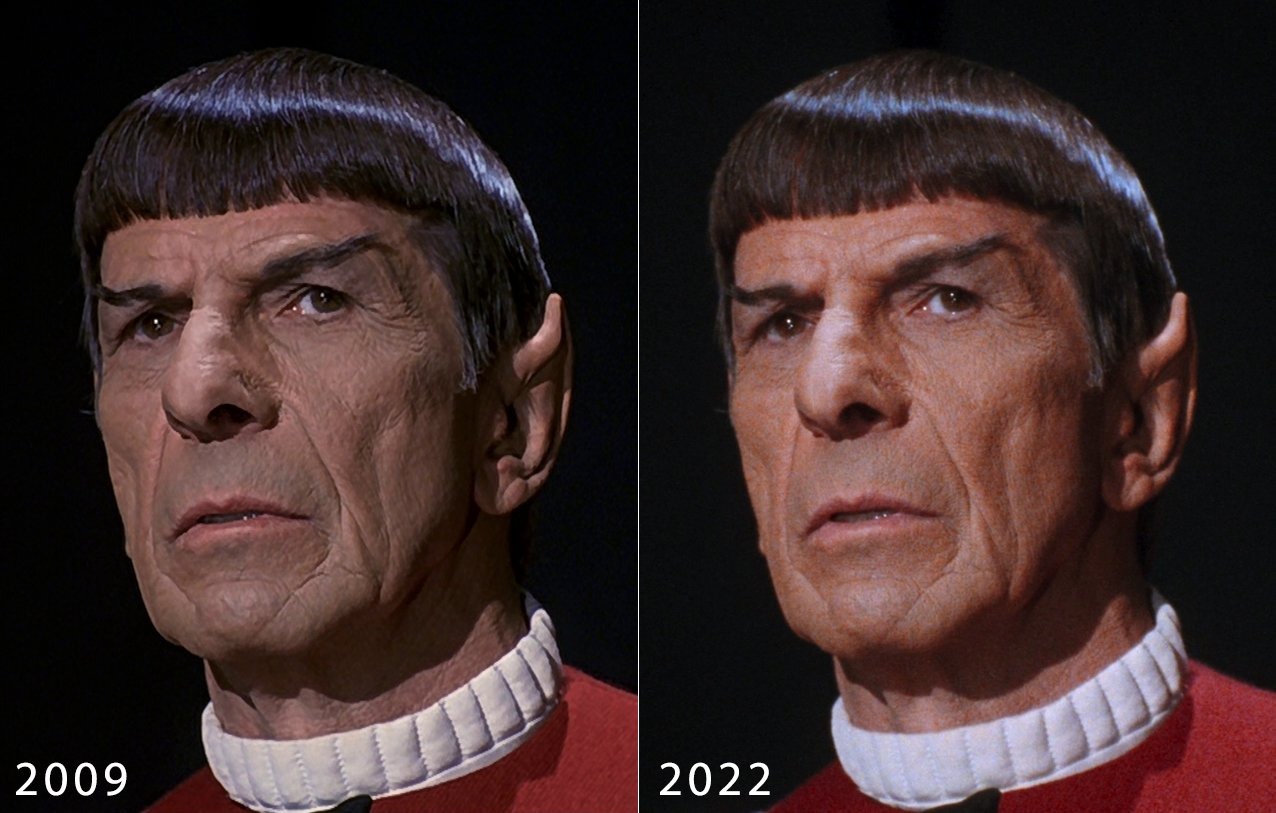

In the new 2022 editions, because the films have been rescanned from the original picture, those 2009-era modifications are not even part of the discussion anymore — restoring the look of each picture to something much closer to the original theatrical presentation.
While some have commented that the 2022 versions seem to be “blurry,” well, that’s because the slightly soft nature of each film were shot that way in the original production!
Because the heavily DNR’d/over-sharpened 2009 editions have been the default way fans have seen these movies for the last 13 years, on both Blu-ray and streaming services, many have little-to-no experience with the films’ original presentation — seen on LaserDisc, VHS, and DVD up until 2009.
Take this close-up of George Takei from Star Trek VI for example: compared to the original HD master used in the 1999 DVD, the new remastered version is a nice upgrade in color and clarity, while still keeping his face looking appropriately detailed.
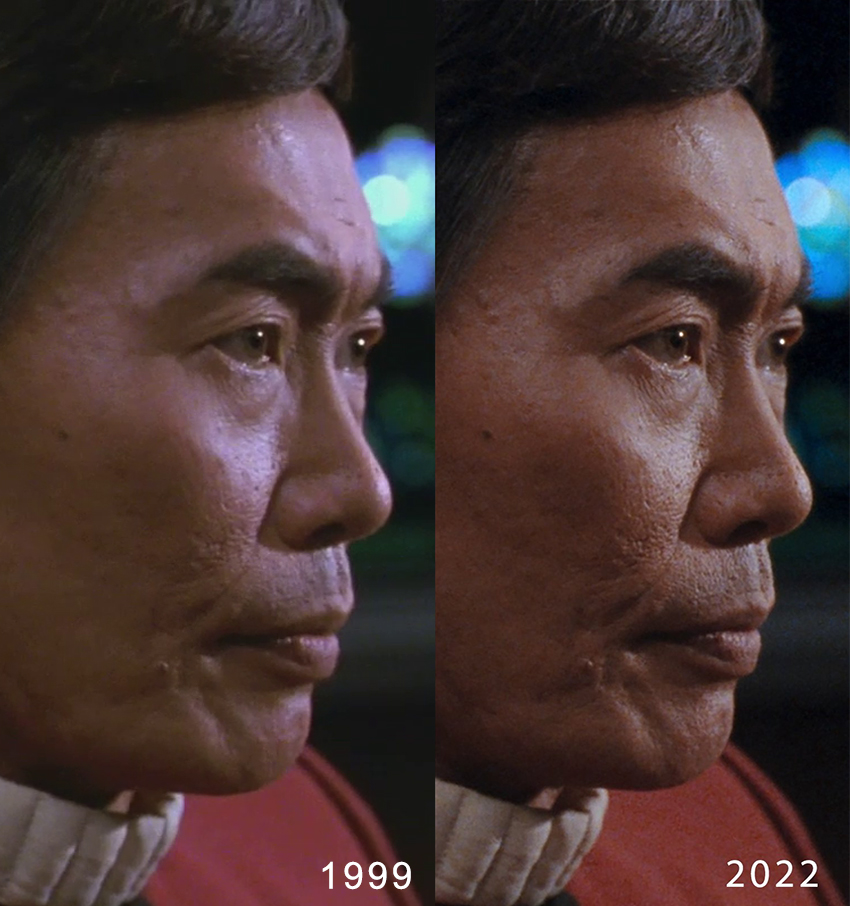
…but as soon as the false-detailed 2009 image is added into the mix, it’s clearly an overcorrection which makes Takei’s face look pitted, adding ten years to his age!
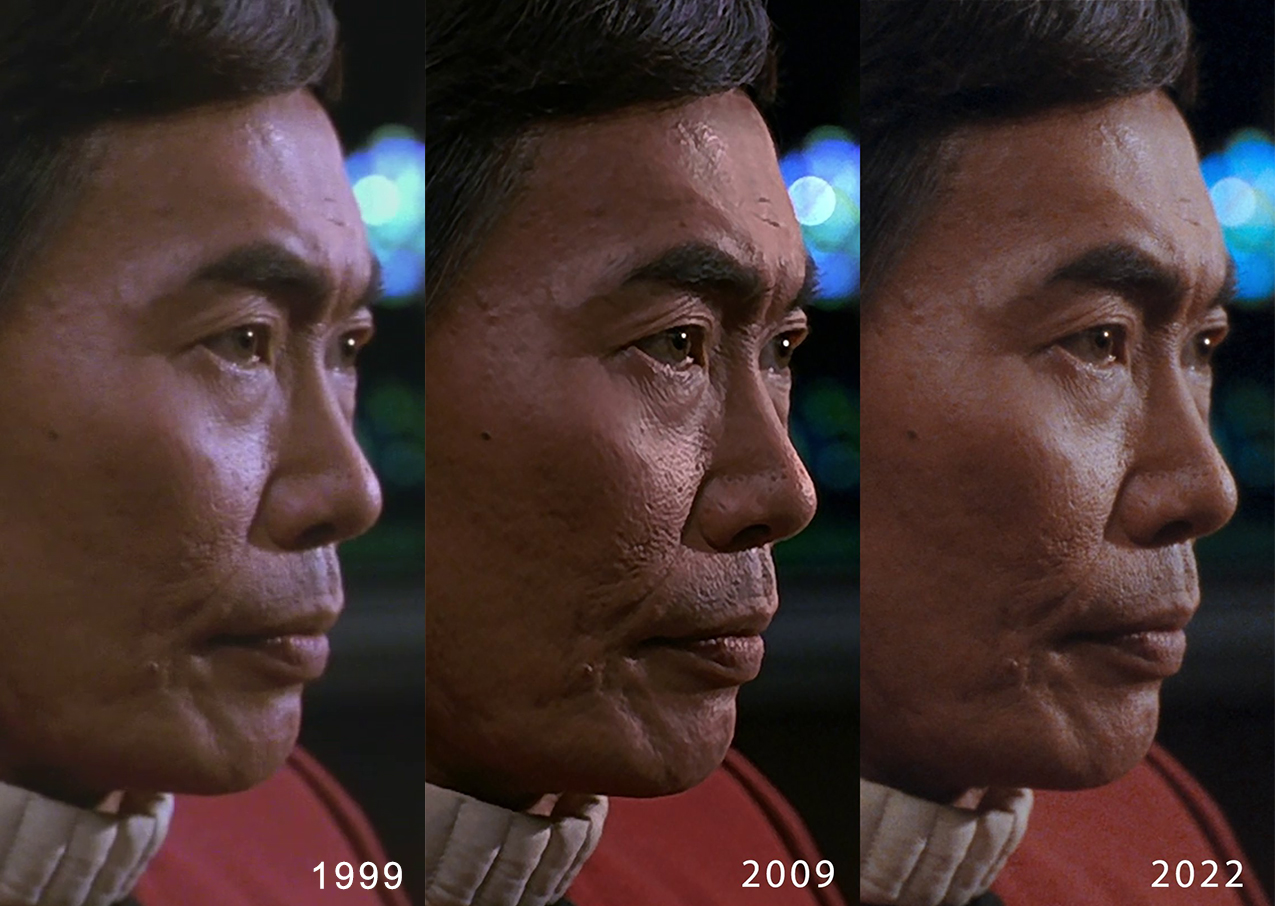
![]()
The theatrical presentation of Star Trek: The Motion Picture features a lovely balance of lighting, color, and texture adjustments (again, without the DNR seen in the 2009 edition) which gives the film more depth — while at the same time toning down strange color casts like the purple lighting seen when McCoy is beamed up to the Enterprise for the first time.
Here are a collection of comparison screencaps between the 2009 Blu-ray and remastered presentations:
Unfortunately, if you are looking to pick up the theatrical cut of The Motion Picture on 4K disc, it’s only available in the multi-film box set — though a standalone Blu-ray of the film is available.
***

For Star Trek II: The Wrath of Khan, the picture quality is identical to the remastered Blu-ray released in 2016, and all bonus features from that first release have been included — and both the theatrical cut and Nick Meyer’s director’s cut of the film are included on 4K and Blu-ray discs using seamless branching.
Here are some 2009 vs. 2016 comparison screencaps we first presented at that time, which include a few comparisons to the original DVD picture illustrating color adjustments.
The remastered editions of Star Trek II are available in the 6-film box set, as a standalone 4K + Blu-ray release, or as a standalone Blu-ray.
***

The new look for Star Trek III: The Search for Spock is full of welcome color corrections, which in some cases rewinds the clock all the way back to the original theatrical presentation. While the Blu-ray disc version still has a few overly-bright issues from the HDR-to-HD down-conversion, overall this film has never looked better, especially when viewed on a full 4K display.
From the start, the title sequence through sky above Genesis has been restored to the original picture width from the theatrical presentation — for some reason, the 2009 Blu-rays pillar-boxed the opening credits, adding black bars to the side of the screens and compressing the picture to fit. The text and framing have now been restored to the original look.
(All screencaps labeled “1984” are from a scan of a 35mm Star Trek III theatrical print.)

Fine details in the Enterprise’s helm console can be made out in the 2021 remaster, including the label on Sulu’s panel which reads THRUSTER IGNITION — while the overall teal-tinted cast has been corrected (blacks and greys are black and grey; skin coloration is must more natural-looking).
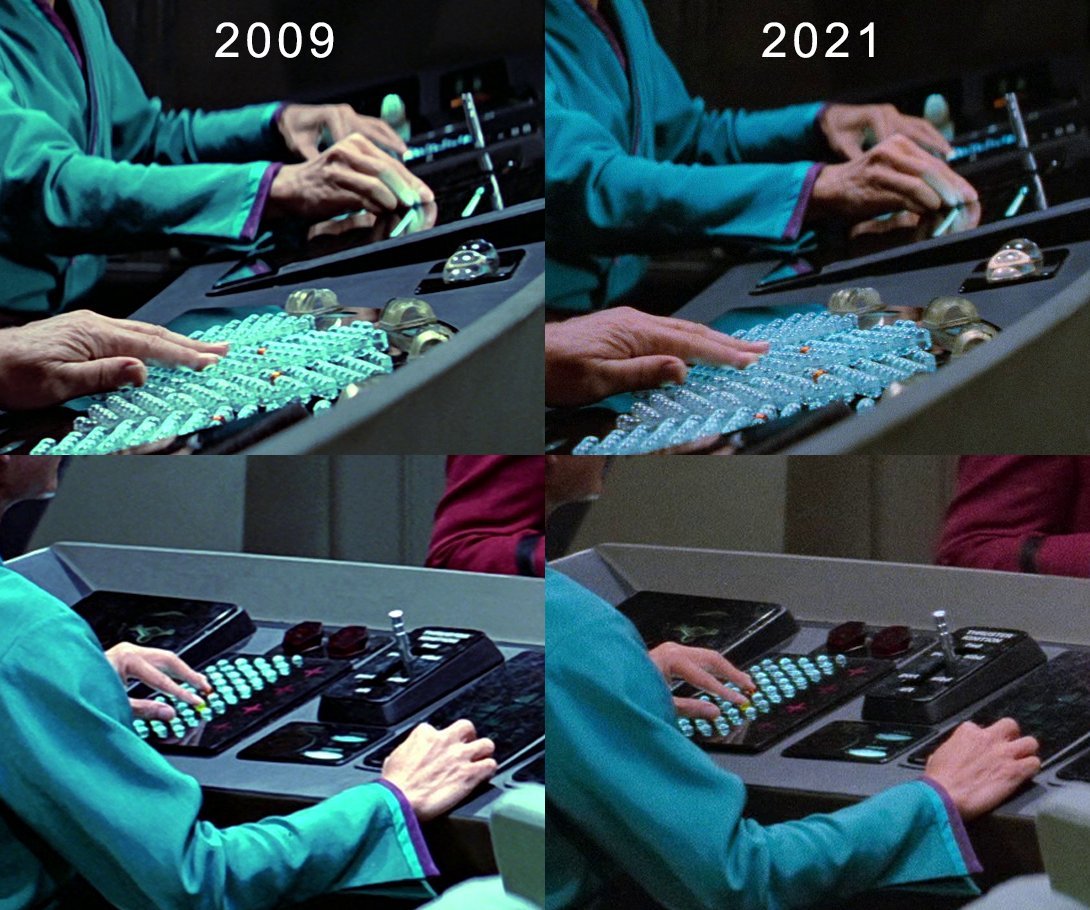
Also notable are changes to the Enterprise bridge set during the final conflict with Kruge; the dark, moody scenes were color-shifted red in for the 2009 Blu-ray release, and have been corrected back to the original blue tones for the modern restoration.
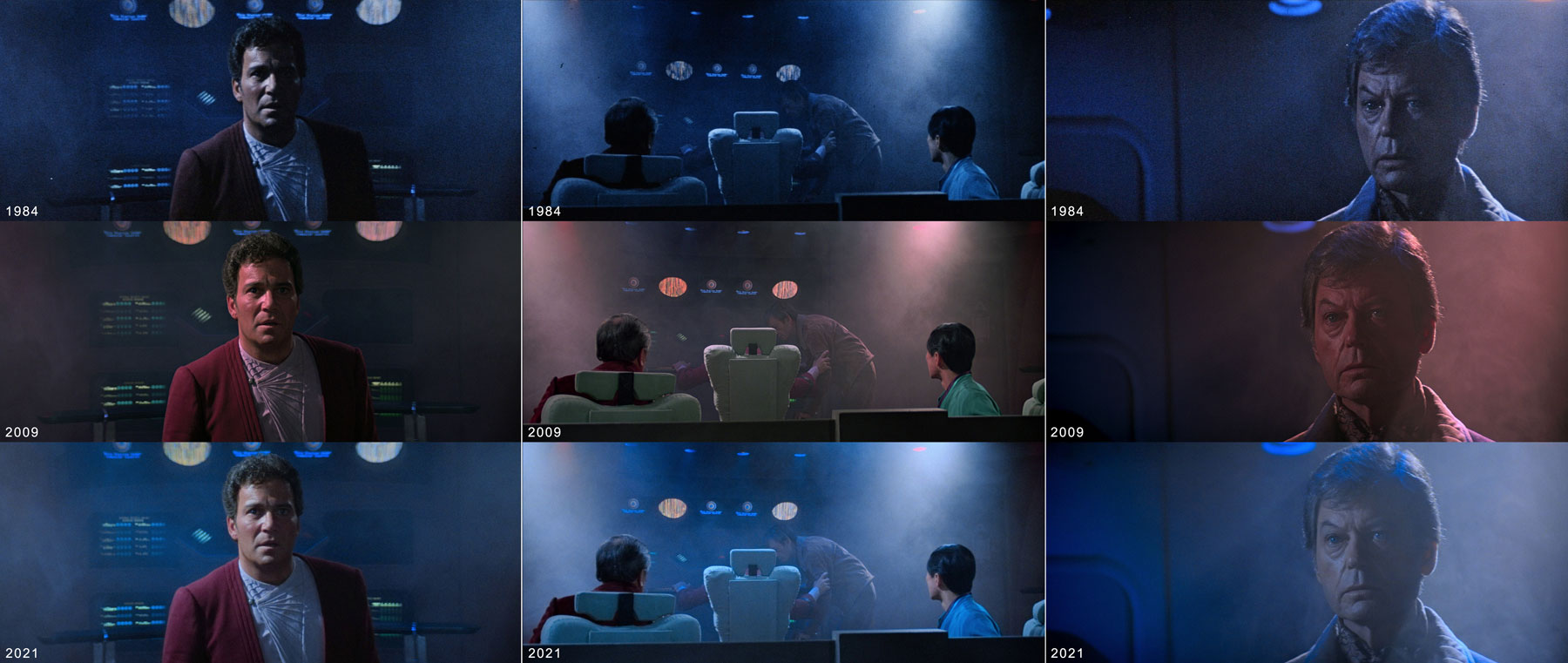
Here are a collection of comparison screencaps between the 2009 Blu-ray and remastered presentations:
The remastered edition of Star Trek III is available in the 6-film box set, as a standalone 4K + Blu-ray release, or as a standalone Blu-ray.
***

Star Trek IV: The Voyage Home fares nicely in the remastered presentation, as the popular “one with the whales” gets its missing film grain restored and thankfully loses the 2009-era slight blue-green cast from its color timing — evident in shots like the Yellow Pages advertisement and the opening debate in the Federation Council chambers.


Outdoor location shots now also look much more like the natural lighting under which they were filmed; Gillian Taylor’s drive-by now reflects the cloudy, overcast San Francisco weather visible in the sky above the actors, rather than the oversaturated coloring seen in the 2009 edition.
In sunny scenes, like Kirk and Spock’s visit to the Cetacean Institute, white fabric like Spock’s robe now carry a warmer tone reflecting the sunlight above the location, rather than a colder blue tone scene in the previous release.
Here are a collection of comparison screencaps between the 2009 Blu-ray and remastered presentations:
The remastered edition of Star Trek IV is available in the 6-film box set, as a standalone 4K + Blu-ray release, or as a standalone Blu-ray.
***

Star Trek V: The Final Frontier also gets a nice new presentation, with a correction to many blown-out highlights and the restoration of more natural-looking colors in a number of scenes — most notably during the Yosemite camping sequences and during the encounter with the Sha Ka Ree “god” near the end of the film.


While some of the blue tones still remain during Sybok’s final moments, the contrast has been dialed back down to near-original levels, allowing viewers to actually see what’s going on during the climactic encounter at the center of the galaxy.
Below, we’ve compared the HD master used for the 1999 DVD release with the 2009 and 2022 Blu-ray editions — the soft blue tones reflecting the Sha Ka Ree “god” remain, but the overall lighting levels have been reduced for a less-blinding experience.
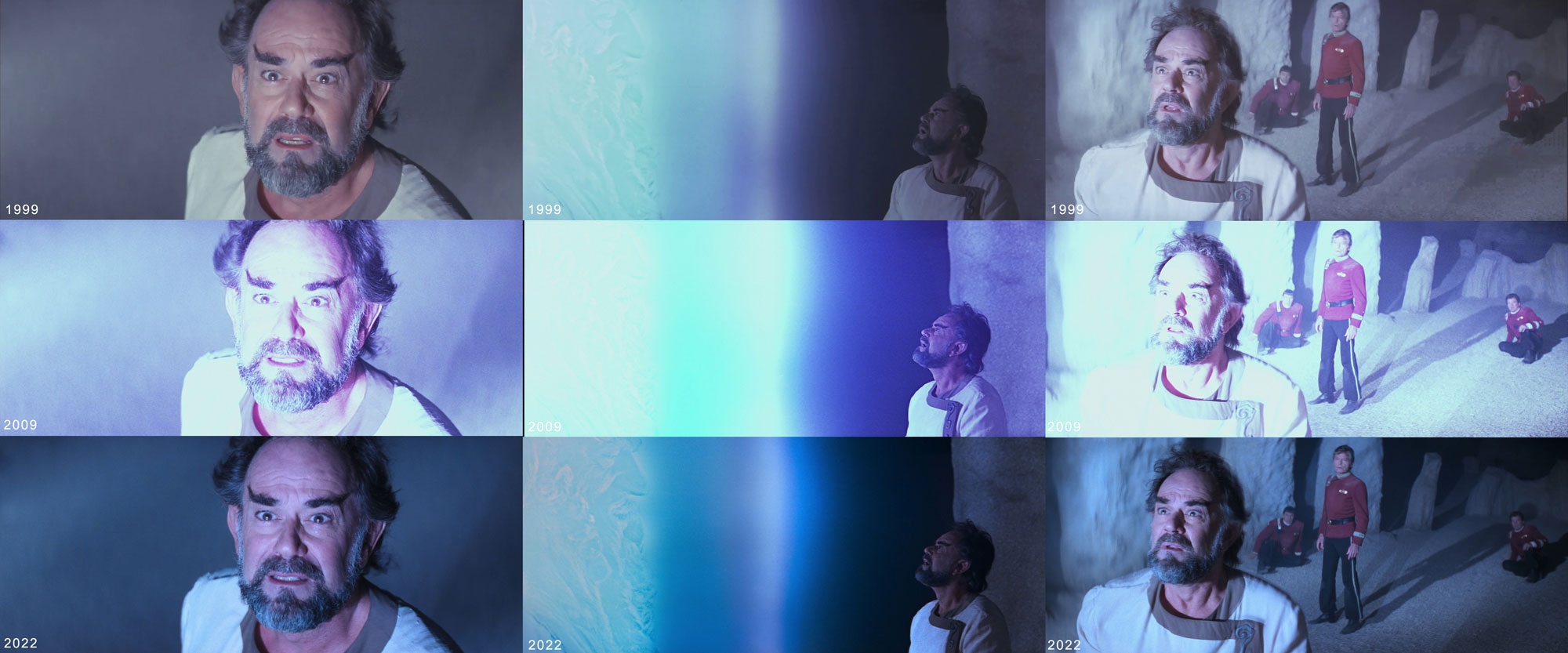
Here are a collection of comparison screencaps between the 2009 Blu-ray and remastered presentations:
The remastered edition of Star Trek V is available in the 6-film box set, as a standalone 4K + Blu-ray release, or as a standalone Blu-ray.
***
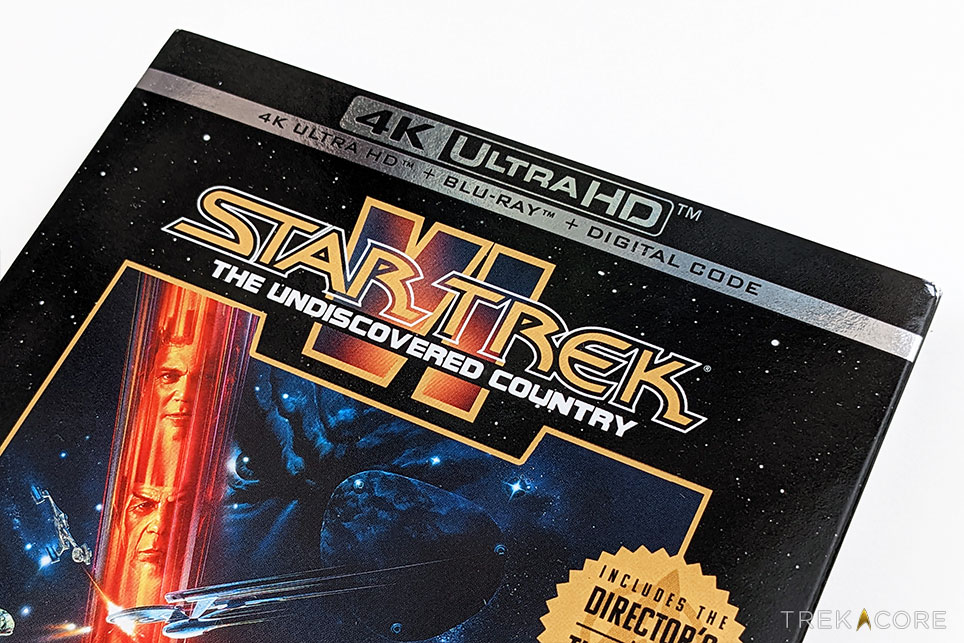
Star Trek VI: The Undiscovered Country arrives with two versions of the film on 4K: the original theatrical cut, which was also available in the previous 2009 Blu-ray (and what most people have seen on streaming services to date), and the longer director’s cut last released in the 2004 Special Collector’s Edition DVD.
(Both cuts of the film are presented in the same 2.39:1 aspect ratio, which is Nick Meyer’s preferred choice; previously the director’s cut was released in a taller 2.00:1 ratio.)
As stated above, this film suffered the most impact from the 2009-era noise-reduction/artificial-sharpening process, and as such benefits the most from the new scan for 2022’s remastered presentation. Gone are the craggy facial features and overly-dark shadowing caused by those filtering tools, and restored are natural skin and costume textures scrubbed away in 2009.
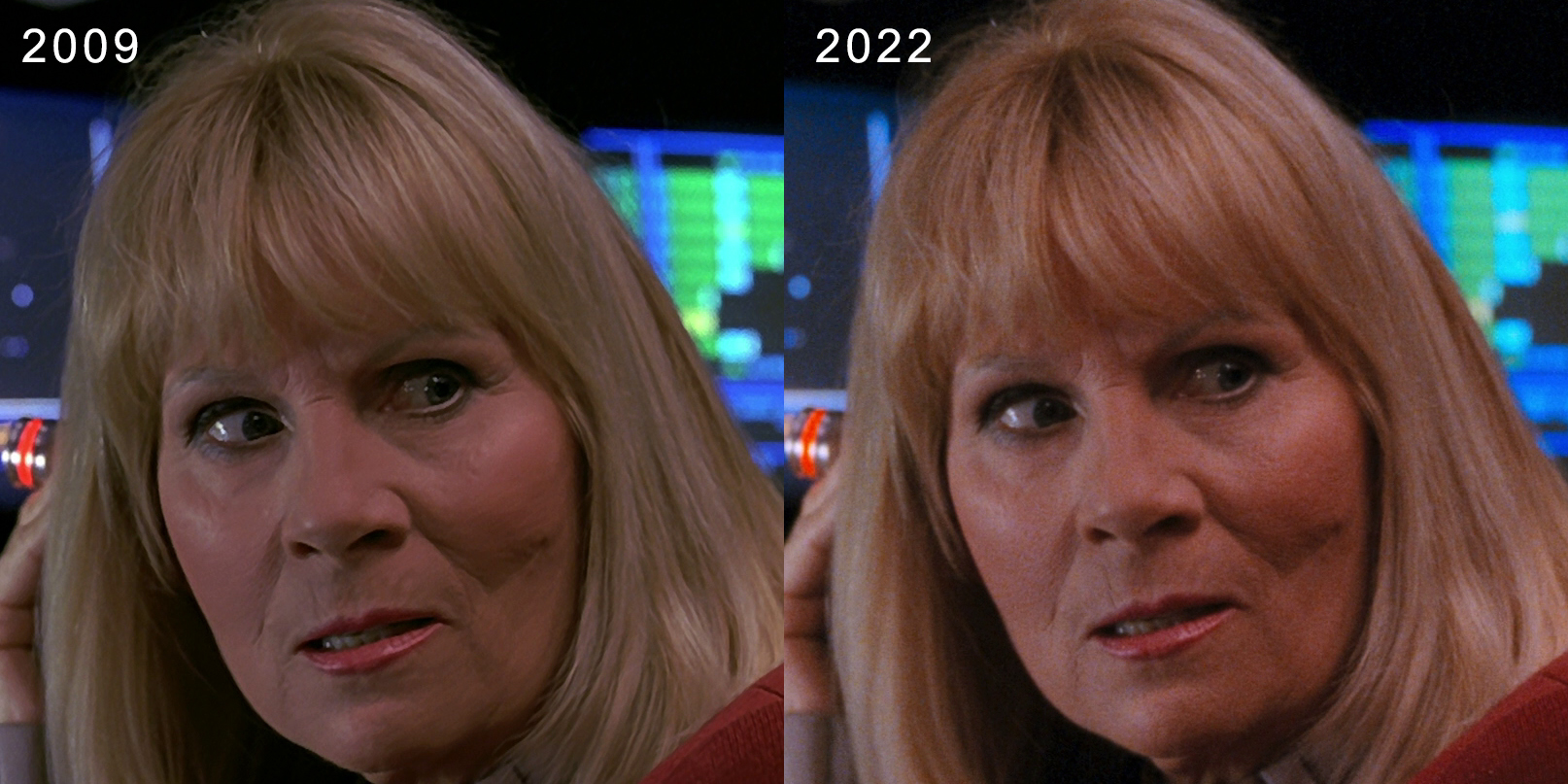
Magentas are dialed way back, most notably seen in the Rura Penthe surface scenes and during the Excelsior’s encounter with the Praxis shockwave. In addition, red colors in this Blu-ray edition of the film — notably in the Starfleet uniforms and Klingon ship environments — do seem to be pushed a bit too far into the orange spectrum, this again may be due to the HDR down-conversion to the 1080p Blu-ray presentation.
(Unfortunately it’s not easy to get representative screencaps from 4K discs and maintain the full HDR color presentation for online publication, but after having watched the film on a proper 4K HDR display, the orange ‘push’ was not noticeable during that viewing.)
This film also seems to be impacted the most by the HDR-to-HD lighting issue, as many scenes in Star Trek VI (on both 4K disc and Blu-ray) appear to be brighter than even the original 1999 DVD picture. The comparison between the three versions illustrates the thankful return to non-DNR’d picture quality in 2022, yet is still brighter than even the ’99 edition.
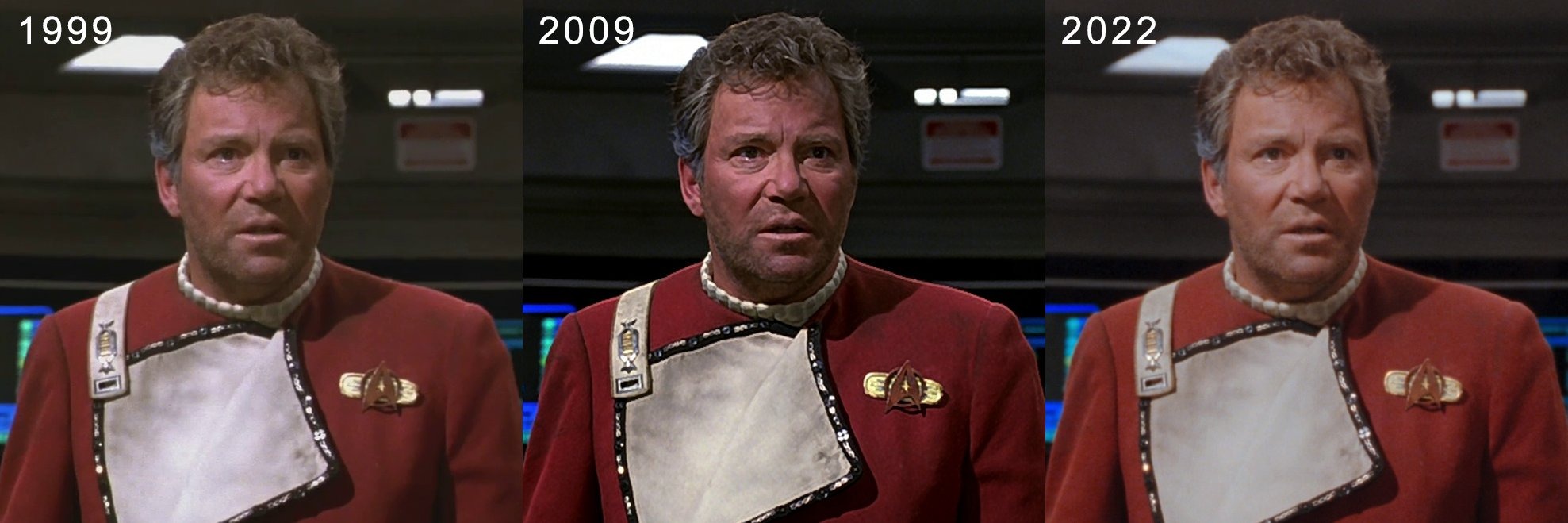
In what is perhaps the biggest misstep of the entire package, the director’s cut of Star Trek VI — which features Rene Auberjonois as Colonel West, West’s reveal as the assassin at the end of the film, and a few other cuts and edits throughout — is only available on the 4K disc, and not included on the remastered Blu-ray disc.
Unlike the Star Trek II director’s cut, these are not just a few trimmed scenes — there are multiple shot changes, different audio cues, and video overlays (the derided flashbacks during the Valeris mind-meld sequence) which require more space on the Blu-ray disc than that storage medium is capable of holding.
Even with seamless branching, both cuts of Star Trek VI won’t fit on a single standard Blu-ray disc, but they will both fit on the large BD-100 disc used for the 4K presentation.

The real solution, of course, would be to have included a second Blu-ray disc to hold the director’s cut in the packaging — but it seems Paramount chose not to do so, perhaps because of the extra cost.
It is still part of the iTunes streaming release ‘bonus features’ however, so if you’ve purchased the film there (or redeemed the included digital code), you’ll be able to watch the Star Trek VI director’s cut in high definition on that service — as well as on Vudu where it is listed as a separate entry from the theatrical edition.
Here are a collection of comparison screencaps between the 2009 Blu-ray and remastered presentation of the Star Trek VI theatrical cut:
The two remastered editions of of Star Trek VI is available in the 6-film box set or as a standalone 4K + Blu-ray release. The theatrical cut is also available as a standalone Blu-ray.
![]()
A few minor quibbles aside, the new Star Trek — The Original Motion Picture 6-Movie Collection is the best way to revisit the big-screen adventures of Captain Kirk and his crew — and these new editions of each film are taking over the old 2009-era presentations on streaming services to bring them to the forefront of viewing options.
Illustrated below from iTunes (picture by @StarTrekVHS on Twitter), the remastered editions of each Star Trek film are identified by the rainbow-colored artwork on many streaming services like Vudu (though not on Paramount+, naturally).
While there’s been no formal announcement, the four films starring the Next Generation cast are expected to get the 4K upgrade next; if things follow the last two years, we should hopefully see them get their own 4K UHD Blu-ray box set by September 2023.
Our coverage of the new Star Trek home media releases will continue later this week, as we dive into the new Star Trek: The Motion Picture — The Director’s Edition 4K edition, and break down all the different versions of the first Star Trek film now available on disc.

